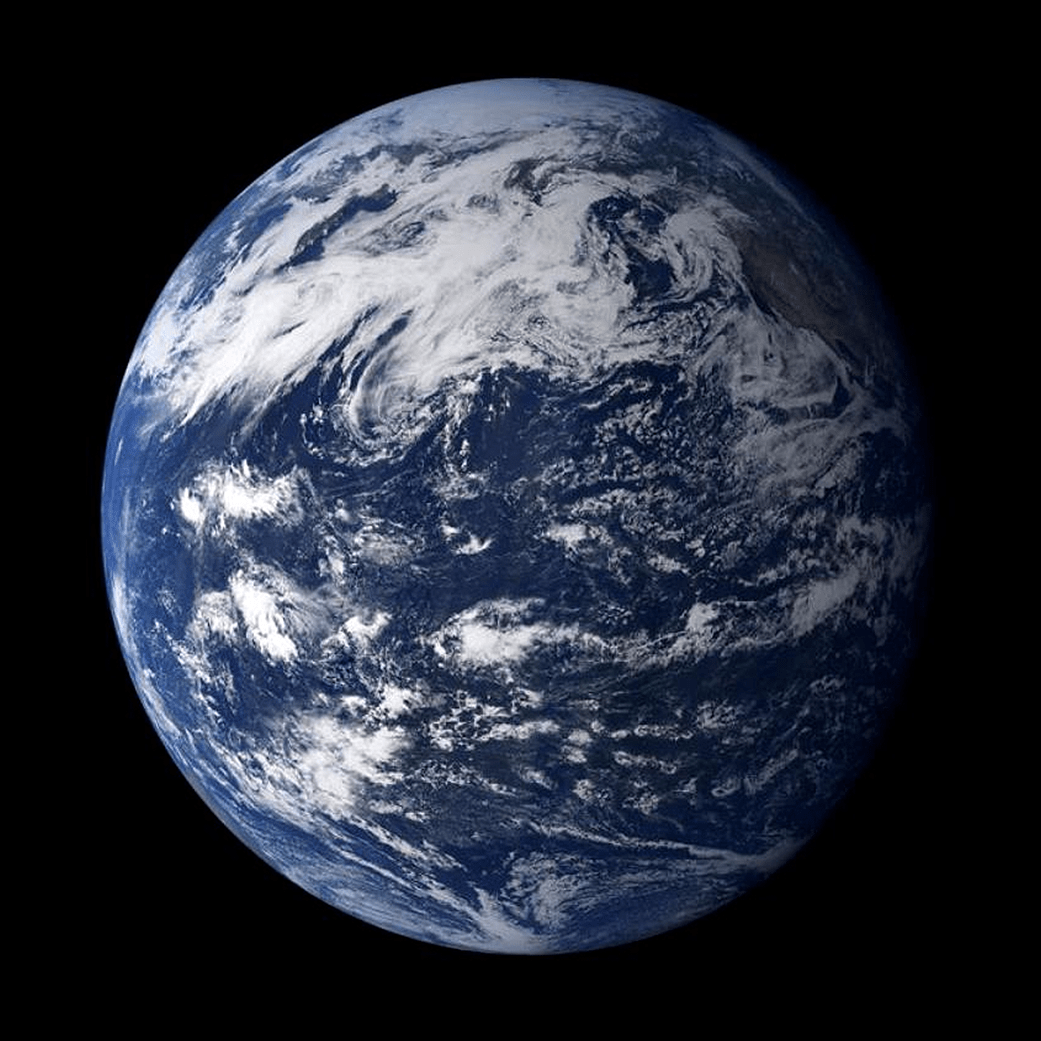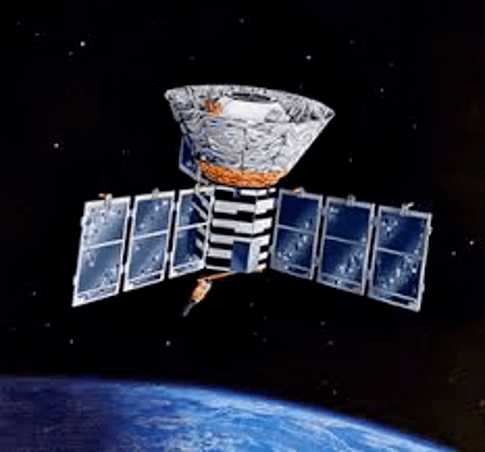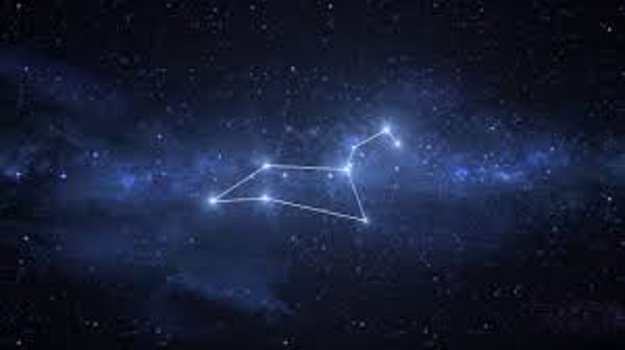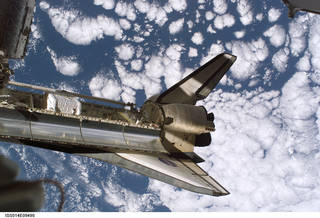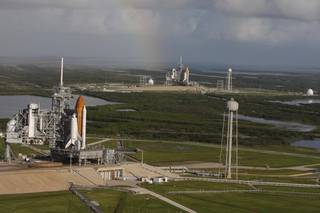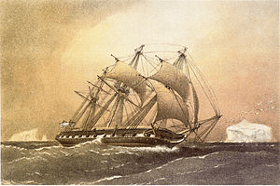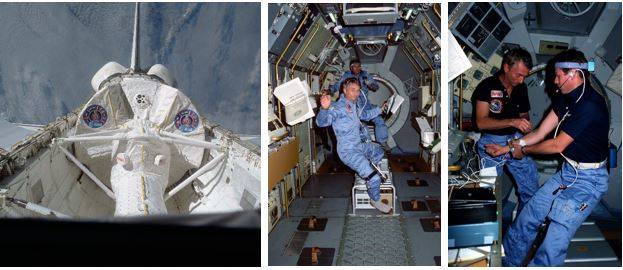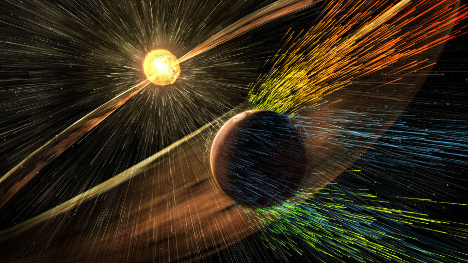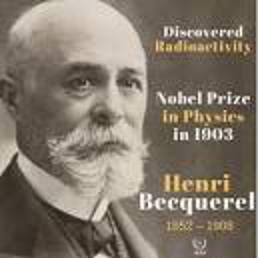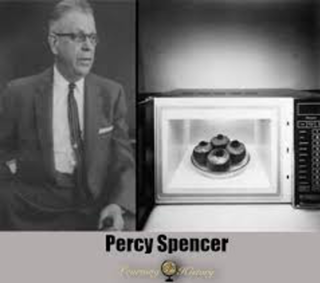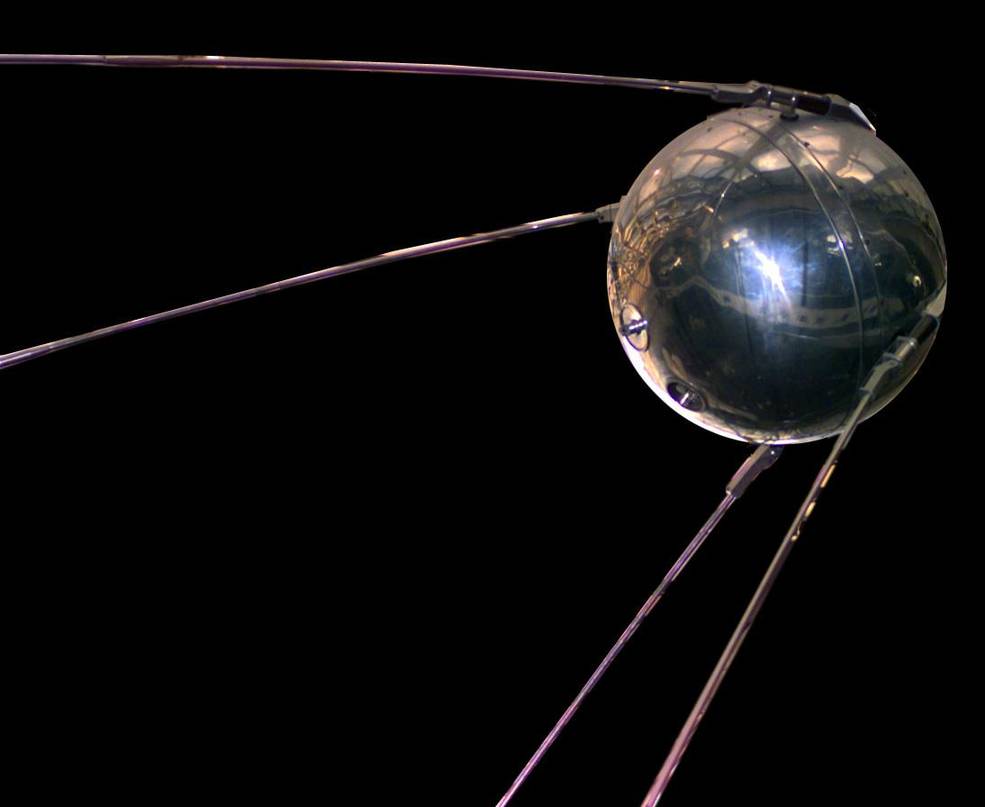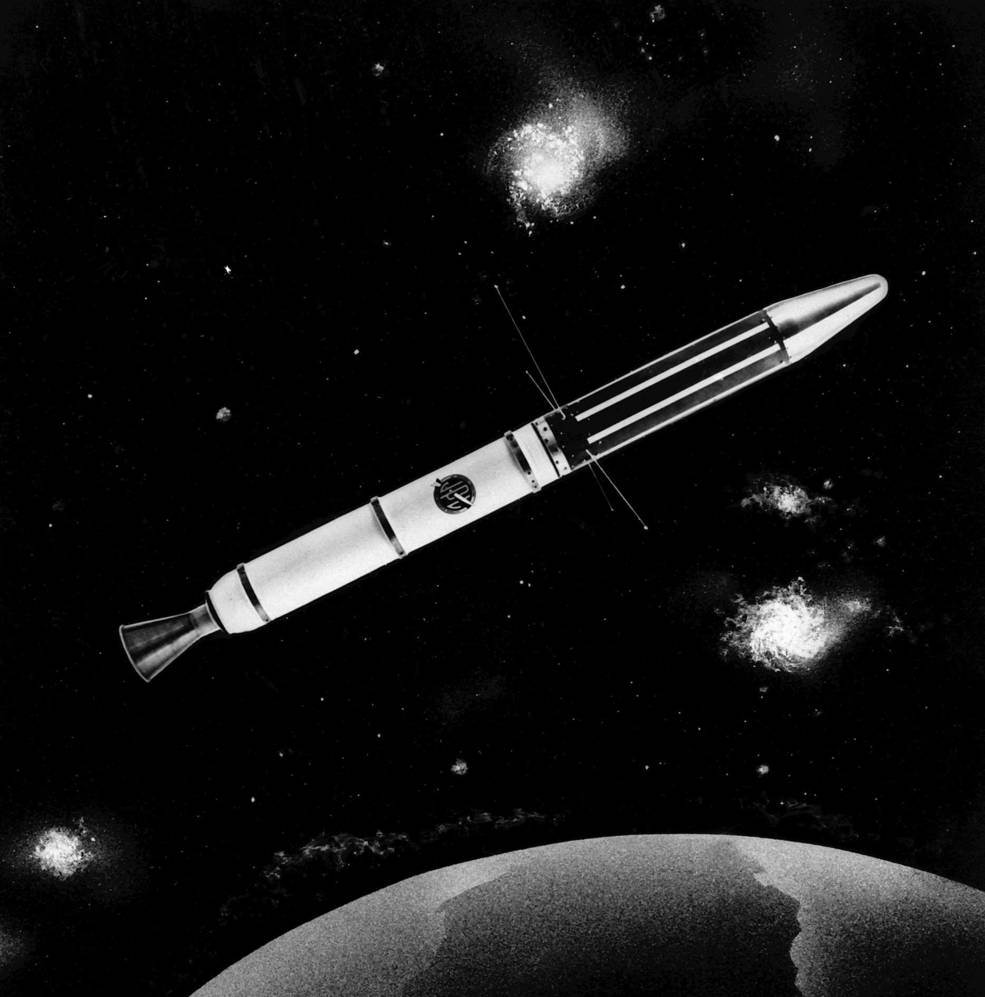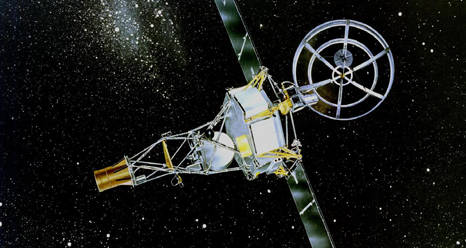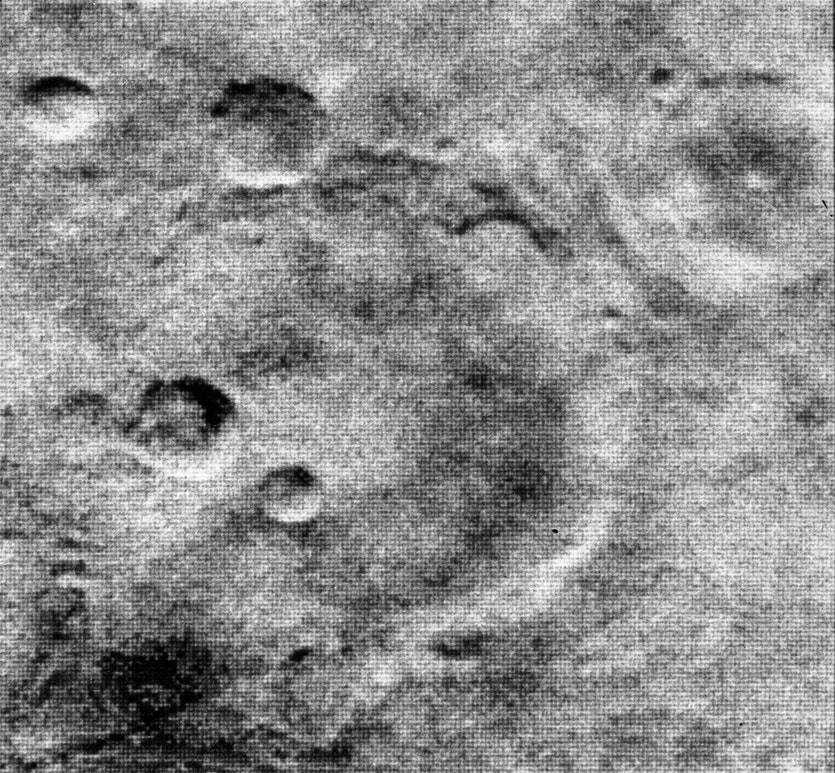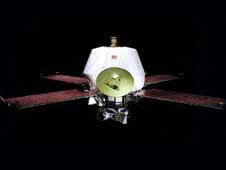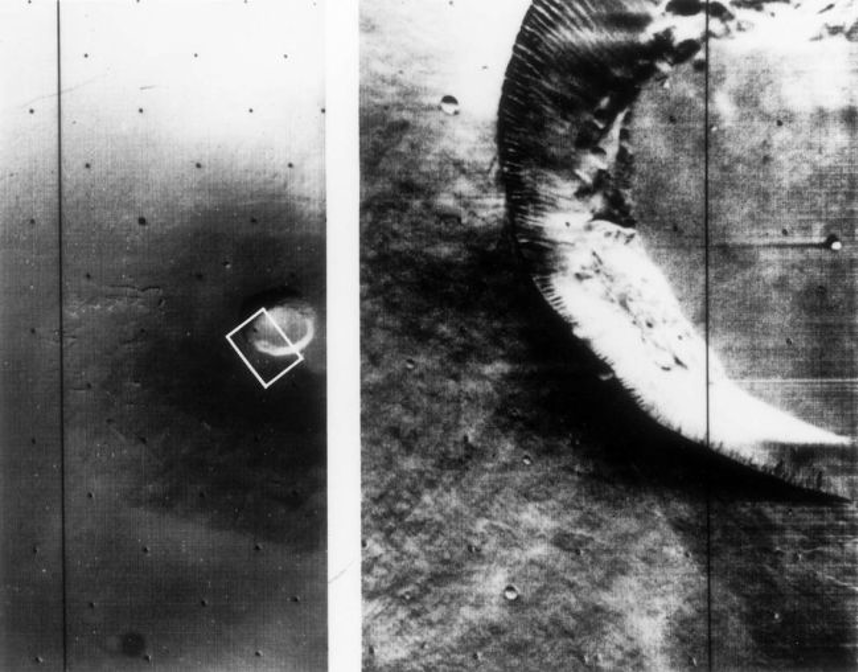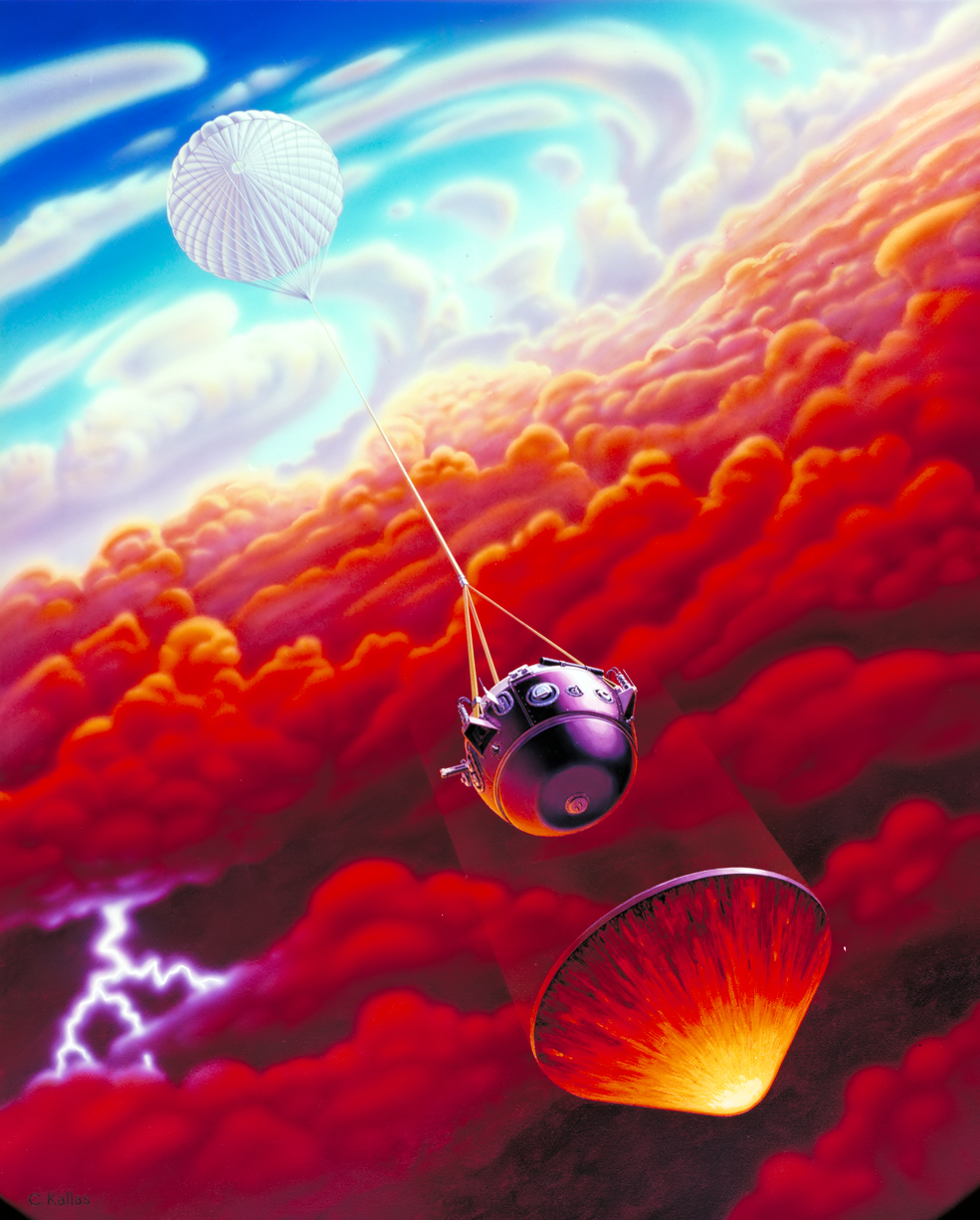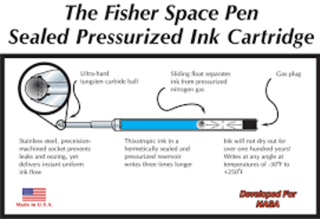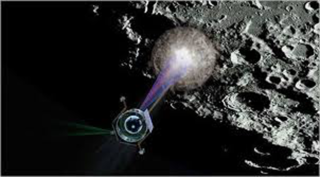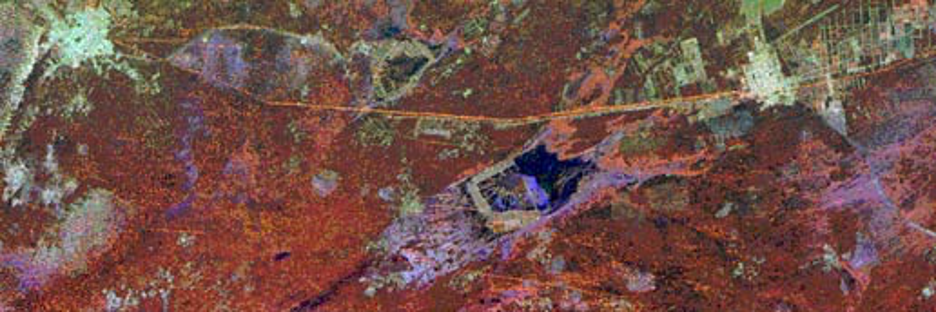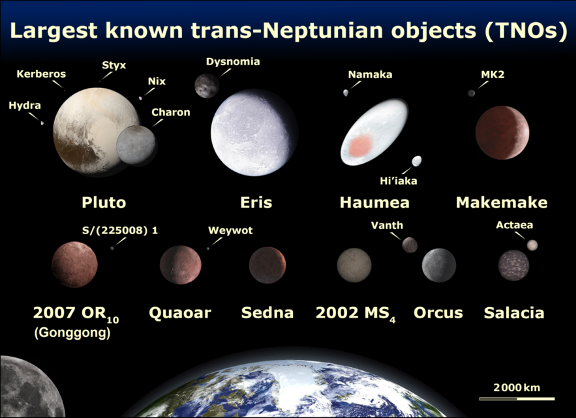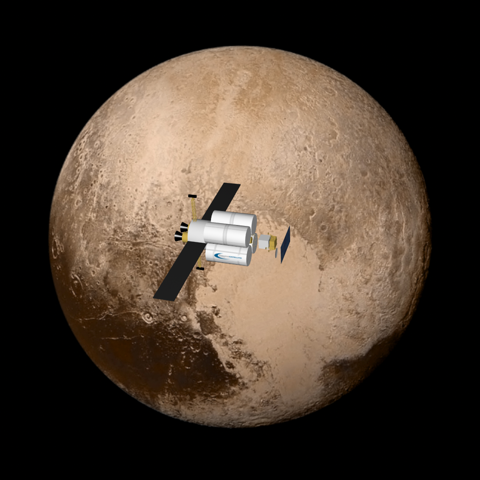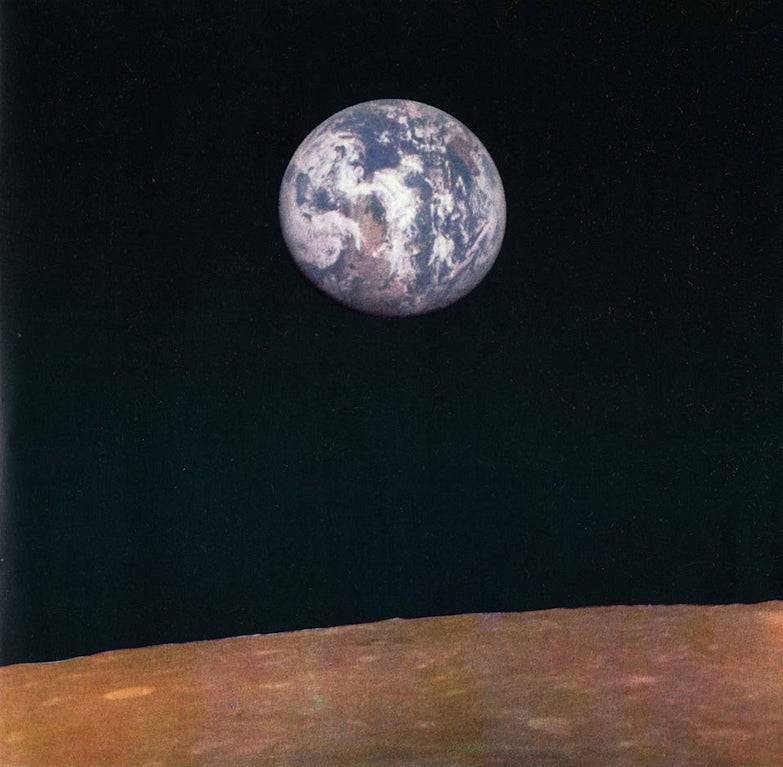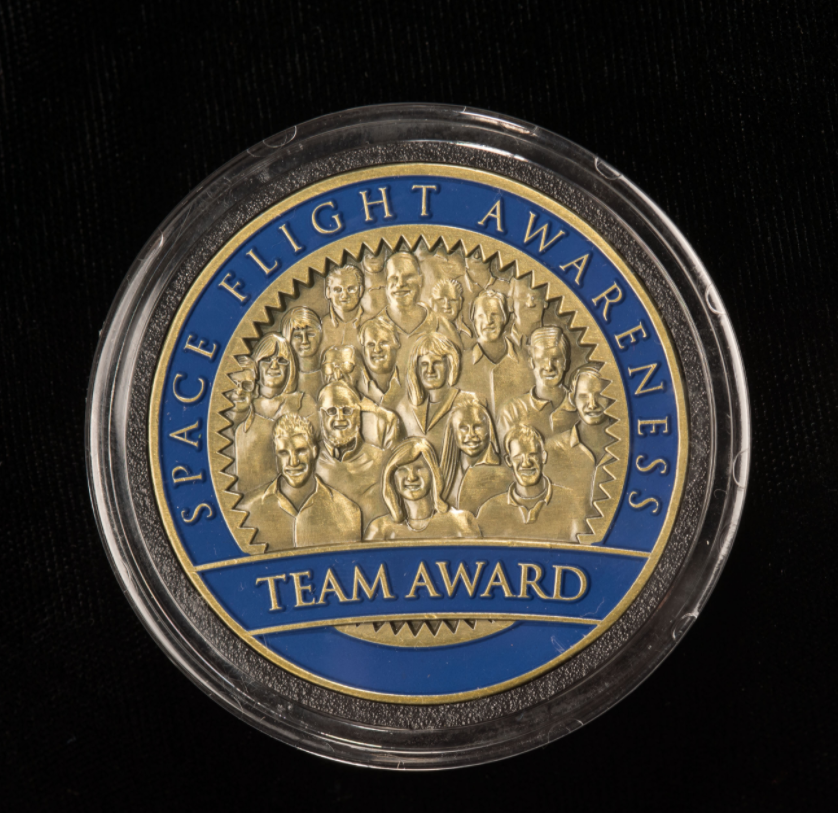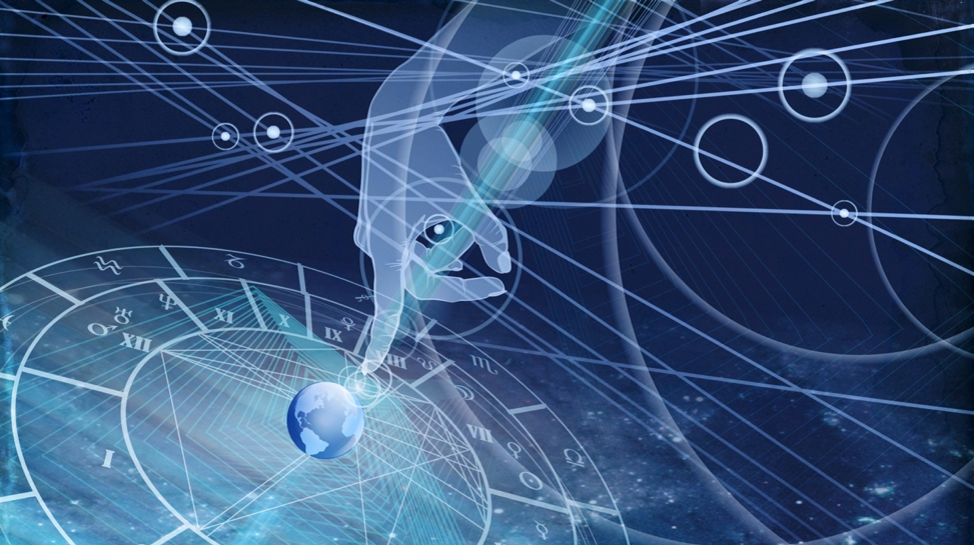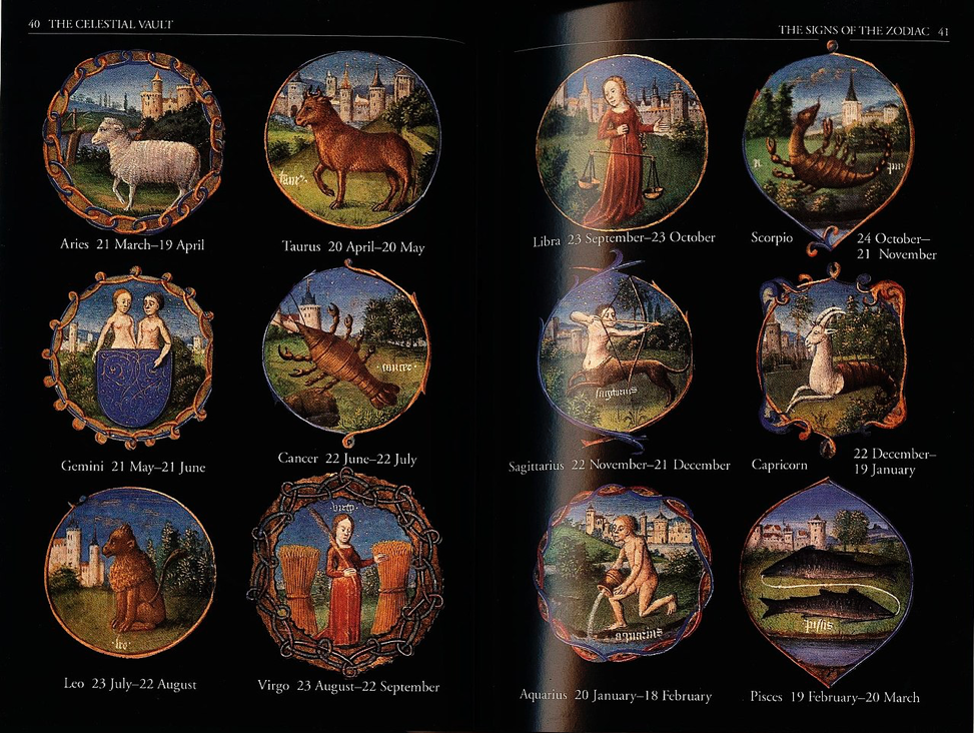December 2020: Interesting Facts about the Earth
So far, we’ve featured some facts about Venus, Mars, Jupiter, and the moon. So perhaps it is time to look at something interesting about our home planet… the Earth!
Earth is the fifth largest of the planets in the solar system, one of four terrestrial planets, (Mercury, Venus, and Mars being the others) that is rocky at the surface. It is the third planet from the sun and the only one known to support an atmosphere with free oxygen, oceans of liquid water on the surface, and — the big one — life. The existence of water in its liquid phase on Earth is due to the temperature span that exists here: 0 to 100 degrees Celsius. Water boils at 100 degrees Celsius, thus converting it into gas and making it unusable for consumption by living beings including humans, animals, and birds, etc. Earth is the only place in the solar system where water can be present in all three states – solid, liquid, and gas.
A truly interesting question about the Earth is how fast is it moving? Earth travels around the Sun at an average velocity of 107,182 kilometers (about 67,000 miles) per hour. At the same time, it is also spinning with enormous speed: rotating once every 23 hours, 56 minutes and 4.09053 seconds (called the sidereal period) and its circumference is roughly 40,075 kilometers. Thus, the surface of the earth at the equator moves at a speed of 460 meters per second–or roughly 1,000 miles per hour. Rockets are often launched from near equatorial latitudes and in the direction of this rotation to take advantage of the extra boost of speed.
Continuing this thought, our solar system–Earth and all–whirls around the center of our galaxy at some 220 kilometers per second, or 490,000 miles per hour. As we consider increasingly large size scales, the speeds involved become absolutely huge! The galaxies in our neighborhood are also rushing at a speed of nearly 1,000 kilometers per second towards a structure called the Great Attractor, a region of space roughly 150 million light-years (one light year is about six trillion miles) away from us. This Great Attractor, having a mass 100 quadrillion times greater than our sun and span of 500 million light-years, is made of both the visible matter that we can see along with the so-called dark matter that we cannot see.
Each of the motions described above was given relative to some structure. Our motion about our sun was described relative to our sun, while the motion of our local group of galaxies was described as toward the Great Attractor. The question arises: Is there some universal frame of reference relative to which we can define the motions of all things? The answer may have been provided by the Cosmic Background Explorer (COBE) satellite.
Cosmic Background Explorer (COBE) satellite
In 1989, the COBE satellite was placed in orbit about the earth (again, the earth is the frame of reference!) to measure the long-diluted radiation echo of the birth of our universe. This radiation, which remains from the immensely hot and dense primordial fireball that was our early universe, is known as the cosmic microwave background radiation (CBR). The CBR presently pervades all of space. It is the equivalent of the entire universe “glowing with heat.”
One of COBE’s discoveries was that the earth was moving with respect to this CBR with a well-defined speed and direction. Because the CBR permeates all space, we can finally answer the question “how fast is the earth moving?” using the CBR as the frame of reference.
The earth is moving with respect to the CBR at a speed of 390 kilometers per second. We can also specify the direction relative to the CBR. It is more fun, though, to look up into the night sky and find the constellation known as Leo (the Lion). The earth is moving toward Leo at the dizzying speed of 390 kilometers per second. It is fortunate that we won’t hit anything out there during any of our lifetimes!
The Constellation Leo
(Thanks and attribution to Dr. Rhett Herman, physics professor at Radford University in Virginia, for much of the above.)
November 2020: Interesting Facts about STARS.
With appreciation and attribution to Earthsky.org, here’s a collection of 10 unexpected, intriguing facts about the stars of our universe – including our sun – that you probably didn’t know!
1. Every star you see in the night sky is bigger and brighter than our sun. Of the 5,000 or so stars brighter than magnitude 6, only a handful of very faint stars are approximately the same size and brightness as our sun and the rest are all bigger and brighter. Of the 500 or so that are brighter than 4th magnitude (which includes essentially every star visible to the unaided eye from an urban location), all are intrinsically bigger and brighter than our sun, many by a large percentage. Of the brightest 50 stars visible to the human eye from Earth, the least intrinsically bright is Alpha Centauri, which is still more than 1.5 times more luminous than our sun, and cannot be easily seen from most of the Northern Hemisphere.
2. You can’t see millions of stars on a dark night. Despite what you may hear in TV commercials, poems and songs, you cannot see a million stars … anywhere. There simply are not enough close enough and bright enough. On a really exceptional night, with no Moon and far from any source of lights, a person with very good eyesight may be able to see 2000-2500 stars at any one time. (Counting even this small number still would be difficult.). So, the next time you hear someone claim to have seen a million stars in the sky, just appreciate it as artistic license or exuberant exaggeration – because it isn’t true!
3. Red hot and cool ice blue – NOT! We are accustomed to referring to things that are red as hot and those that are blue as cool. This is not entirely unreasonable, since a red, glowing fireplace poker is hot and ice, especially in glaciers and polar regions, can have a bluish cast. But we say that only because our everyday experience is limited. In fact, heated objects change color as their temperature changes, and red represents the lowest temperature at which a heated object can glow in visible light. As it gets hotter, the color changes to white and ultimately to blue. So the red stars you see in the sky are the “coolest” (least hot), and the blue stars are the hottest!
4. Stars are black bodies. A black body is an object that absorbs 100 percent of all electromagnetic radiation (that is, light, radio waves and so on) that falls on it. A common image here is that of a brick oven with the interior painted black and the only opening a small window. All light that shines through the window is absorbed by the interior of the oven and none is reflected outside the oven. It is a perfect absorber. As it turns out, this definition of being perfect absorbers suits stars very well! However, this just says that a black body absorbs all the radiant energy that hits it, but does not forbid it from re-emitting the energy. In the case of a star, it absorbs all radiation that falls on it, but it also radiates back into space much more than it absorbs. Thus, a star is a black body that glows with great brilliance! (An even more perfect black body is a black hole, but of course, it appears truly black, and radiates no light.)
5. There are no green stars. Although there are scattered claims for stars that appear green, including Beta Librae (Zuben Eschamali), most observers do not see green in any stars except as an optical effect from their telescopes, or else an idiosyncratic quirk of personal vision and contrast. Stars emit a spectrum (“rainbow”) of colors, including green, but the human eye-brain connection mixes the colors together in a manner that rarely if ever comes out green. One color can dominate the radiation, but within the range of wavelengths and intensities found in stars, greens get mixed with other colors, and the star appears white. For stars, the general colors are, from lower to higher temperatures, red, orange, yellow, white and blue. So as far as the human eye can tell, there are no green stars.
6. Our sun is a green star. That being said, the sun is a “green” star, or more specifically, a green-blue star, whose peak wavelength lies clearly in the transition area on the spectrum between blue and green. This is not just an idle fact, but is important because the temperature of a star is related to the color of its most predominate wavelength of emission. (Whew!) In the sun’s case, the surface temperature is about 5,800 K, or 500 nanometers, a green-blue. However, as indicated above, when the human eye factors in the other colors around it, the sun’s apparent color comes out a white or even a yellowish white.
7. Our sun is a dwarf star. We are accustomed to think of the sun as a “normal” star, and in many respects, it is. But did you know that it is a “dwarf” star? You may have heard of a “white dwarf,” but that is not a regular star at all, but the corpse of a dead star. Technically, as far as “normal” stars go (that is, astronomical objects that produce their own energy through sustained and stable hydrogen fusion), there are only “dwarfs,” “giants” and “supergiants.” The giants and supergiants represent the terminal (old age) stages of stars, but the vast majority of stars, those in the long, mature stage of evolution (Main Sequence) are all called “dwarfs.” There is quite a bit of range in size here, but they are all much smaller than the giants and supergiants. So technically, the sun is a dwarf star, sometimes called “Yellow Dwarf” in contradiction to the entry above!
8. Stars don’t twinkle. Stars appear to twinkle (“scintillate”), especially when they are near the horizon. One star, Sirius, twinkles, sparkles and flashes so much some times that people actually report it as a UFO. But in fact, the twinkling is not a property of the stars, but of Earth’s turbulent atmosphere. As the light from a star passes through the atmosphere, especially when the star appears near the horizon, it must pass through many layers of often rapidly differing density. This has the effect of deflecting the light slightly as it were a ball in a pinball machine. The light eventually gets to your eyes, but every deflection causes it to change slightly in color and intensity. The result is “twinkling.” Above the Earth’s atmosphere, stars do not twinkle.
9. You can see 20 quadrillion miles, at least. On a good night, you can see about 19,000,000,000,000,000 miles, easily. That’s 19 quadrillion miles, the approximate distance to the bright star Deneb in Cygnus. which is prominent in the evening skies of Fall and Winter. Deneb is bright enough to be seen virtually anywhere in the northern hemisphere, and in fact from almost anywhere in the inhabited world. There is another star, Eta Carina, that is a little more than twice as far away, or about 44 quadrillion miles. But Eta Carina is faint, and not well placed for observers in most of the Northern hemisphere. Those are stars, but both the Andromeda Galaxy and the Triangulum Galaxy are also visible under certain conditions, and are roughly 15 and 18 quintillion miles away! (One quintillion is 10^18!)
10. Black holes don’t suck. Many writers frequently describe black holes as “sucking” in everything around them. And it is a common worry among the ill-informed that the so-far hypothetical “mini” black holes that may be produced by the Large Hadron Collider would suck in everything around them in an ever-increasing vortex that would consume the Earth! “Say it ain’t so, Joe!” Well, I am not Shoeless Joe Jackson, but it ain’t so. In the case of the LHC, it isn’t true for a number of reasons, but black holes, in general, do not “suck.”
This not just a semantic distinction, but one of process and consequence as well. The word “suck” via suction, as in the way vacuum cleaners work, is not how black holes attract matter. In a vacuum cleaner, the fan produces a partial vacuum (really, just a slightly lower pressure) at the floor end of the vacuum, and regular air pressure outside, being greater, pushes the air into it, carrying along loose dirt and dust.
In the case of black holes, there is no suction involved. Instead, matter is pulled into the black hole by a very strong gravitational attraction. In one way of visualizing it, it really is a bit like falling into a hole, but not like being hoovered into it. Gravity is a fundamental force of Nature, and all matter has it. When something is pulled into a black hole, the process is more like being pulled into like a fish being reeled in by an angler, rather than being pushed along like a rafter inexorably being dragged over a waterfall.
The difference may seem trivial, but from a physical standpoint, it is fundamental.
So black holes don’t suck, but they are very cool. Actually, they are cold. Very, very cold. But that’s a story for another time.
If you enjoyed these items, you can sign up for EarthSky’s free daily newsletter at:
https://earthsky.us1.list-manage.com/subscribe?u=e56e7a92b1c5790f7343ef95a&id=c643945d79
October 2020: The Space Shuttle
Yes, the space shuttle would seem to be old news. But since it was the backbone of NASA’s space and science exploration endeavor for 30 years before its forced retirement in 2011, perhaps it would be worthwhile to reflect nostalgically on its history, contributions, and a few fascinating facts about it.
The Space Shuttle was a partially reusable low Earth orbital spacecraft system that was composed of an orbiter launched with two reusable solid rocket boosters and a disposable external fuel tank. It carried up to eight astronauts and up to 50,000 lb (23,000 kg) of payload into low Earth orbit (LEO). When its mission was complete, the orbiter would re-enter the Earth’s atmosphere and lands like a glider at either the Kennedy Space Center or Edwards Air Force Base.
The Shuttle was the only winged crewed spacecraft to have achieved orbit and landing, and the only reusable crewed space vehicle that has ever made multiple flights into orbit (the Russian shuttle Buran was very similar and was designed to have the same capabilities but made only one uncrewed spaceflight before it was canceled). Its missions involved carrying large payloads to various orbits, including segments to be added to the International Space Station (ISS), providing crew rotation for the space station, and performing service missions on the Hubble Space Telescope. The orbiter also recovered satellites and other payloads (e.g., from the ISS) from orbit and returned them to Earth, though its use in this capacity was rare. Each vehicle was designed with a projected lifespan of 100 launches, or 10 years’ operational life. Original selling points on the shuttles were over 150 launches over a 15-year operational span with a ‘launch per month’ expected at the peak of the program, but extensive delays in the development of the International Space Station never created such a peak demand for frequent flights.
The first experimental orbiter named Enterprise was a high-altitude glider, launched from the back of a specially modified Boeing 747, only for initial atmospheric landing tests (ALT). Enterprise’s first test flight was on February 18, 1977, only five years after the Shuttle program was formally initiated; leading to the launch of the first space-worthy shuttle Columbia on April 12, 1981, on STS-1. The Space Shuttle program finished with its last mission, STS-135 flown by Atlantis, in July 2011, retiring the final Shuttle in the fleet. The Space Shuttle program formally ended on August 31, 2011.
How did the Space Shuttle fleet get its names, you ask? They were all named after sailing ships:
- Columbia (OV-102) was named after a sailing frigate launched in 1836. It was one of the first Navy ships to circumnavigate the globe. The name also was used for the Apollo 11 command module that carried Neil Armstrong, Buzz Aldrin and Michael Collins on the first lunar landing flight in 1969.
- Challenger (OV-099) was named after a Navy ship, which from 1872 to 1876 made a prolonged exploration of the Atlantic and Pacific oceans. The name also was used for the Apollo 17 lunar excursion module (LEM).
- Discovery (OV-103) was named after two ships – one in which Henry Hudson in 1610-11 attempted to search for a northwest passage between the Atlantic and Pacific oceans and instead discovered Hudson Bay and another in which Capt. Cook explored the Hawaiian Islands and explored southern Alaska and western Canada.
- Atlantis (OV-104) was named after a two-masted ketch operated for the Woods Hole Oceanographic Institute from 1930 to 1966. That sailboat traveled more than half a million miles in ocean research.
- Endeavour (OV-105) was named after the first ship commanded by 18th century British explorer James Cook. On its maiden voyage in 1788, Cook sailed into the South Pacific and around Tahiti to observe the passage of the planet Venus between the Earth and the Sun. During another leg of the journey, Cook reached New Zealand, surveyed Australia and navigated the Great Barrier Reef.
A few more interesting facts:
1. Top speed
While in orbit, the space shuttle traveled around Earth at a speed of about 17,500 miles (28,000 kilometers) per hour. At this speed, the crew saw a sunrise or sunset every 45 minutes.
2. Well-traveled
The combined mileage of all five orbiters is 513.7 million miles (826.7 million km), or 1.3 times the distance between Earth and Jupiter. Each orbiter, except for Challenger, traveled farther than the distance between Earth and the sun.
3. Presidential attention
Only one president has been on hand to witness a space shuttle launch. President Bill Clinton, along with his wife Hillary Clinton, watched Mercury astronaut John Glenn’s return to space on the STS-95 flight on Oct. 29, 1998 from the Kennedy Space Center in Florida.
President Obama had planned to watch the shuttle Endeavour lift off on its final mission STS-134, on April 29, 2011, but that launch was delayed. The President and his family did visit the spaceport anyway.
4. Space science
The space shuttle isn’t just a mode of transport: It’s a laboratory, too. There have been 22 Spacelab missions, or missions, where science, astronomy, and physics have been studied inside a special module, carried on the space shuttle.
Spacelab, a reusable laboratory built for use on space shuttle flights, allowed scientists to perform experiments in microgravity. Starting with 1983’s Challenger missions, animals became a prime component of space science. On the STS-7 mission, the social activities of ant colonies in zero gravity were examined, and during STS-8, six rats were flown in the Animal Enclosure module to study animal behavior in space.
5. Taking the heat
The space shuttle’s Thermal Protection System, or heat shield, contains more than 30,000 tiles that are constructed essentially of sand.
All of the tiles are thoroughly inspected before liftoff – they are a crucial tool that allowed the space shuttle to endure the intense heat endured when the shuttle re-enters Earth’s atmosphere to land. After the tiles are heated to peak temperature, the tiles can cool fast enough to be held in your hand only a minute later.
6. Packing on the pounds
The heaviest space shuttle orbiter, Columbia, weighed 178,000 pounds (80,700 kg), roughly the weight of 13 African Elephants. Columbia, the first space shuttle to fly, weighed the most because NASA was still searching for lighter materials to use, and integrated some of these into the later orbiters.
7. Official monikers
The space shuttle program is officially known as the Space Transportation System (STS), and so each shuttle mission is designated with the prefix “STS.”
Initially, the missions were given sequential numbers indicating their order of launch, from STS-1 through STS-9. However, because the then-NASA administrator James Beggs suffered from triskaidekaphobia (fear of the number 13) and wanted to avoid associations with the unlucky Apollo 13 mission, the agency drew up a new numbering system for space shuttle missions, according to NASA history accounts by several astronauts at time.
What would have been STS-11 was named STS-41-B, STS-12 became STS-41-C, and STS-13 was STS-41-D. The first number was the last digit in the fiscal year (1984), the second number indicated the launch site (1 for Kennedy Space Center, and 6 for Vandenberg Air Force Base), and the letter indicated the sequence (A was the first launch of the year, and so on).
After the 1986 Challenger shuttle disaster, when that orbiter and its STS-51-L mission crew were lost, the agency resumed the sequential numbering system, starting with STS-26.
8. Tweeting from space
On May 11, 2009, astronaut Michael J. Massimino, a crewmember of the space shuttle Atlantis’ STS-125 mission, became the first person to use the microblogging site Twitter in space.
Writing as @Astro Mike, he tweeted “From orbit: Launch was awesome!! I am feeling great, working hard, & enjoying the magnificent views, the adventure of a lifetime has begun!”
Since then, many astronauts from NASA and other space agencies have posted Twitter messages from space. One, NASA spaceflyer Doug Wheelock, won a Twitter Shorty Award earlier this year for the posts and photos he shared from space using the website during his months-long stay aboard the International Space Station.
For NASA’s final space shuttle mission, all four of Atlantis’ crewmembers had Twitter alias. They were: commander Chris Ferguson (@Astro_Ferg), pilot Doug Hurley (@Astro_Doug), mission specialist Sandy Magnus (@Astro_Sandy) and mission specialist Rex Walheim (@Astro_Rex).
Atlantis’s final mission was STS-135 which flew a 12-day mission to deliver vital supplies and spare parts to the International Space Station. NASA retired all three of its shuttles after 30 years to make way for a new program aimed at sending astronauts on deep space missions to an asteroid and other target.
https://www.space.com/12127-8-surprising-space-shuttle-facts.html
https://en.wikipedia.org/wiki/Space_Shuttle_program
https://en.wikipedia.org/wiki/Space_Shuttle_Enterprise
September 2020: The Solar Wind
The solar wind is a stream of energetic particles ejected by the Sun. These include electrons and protons from hydrogen, along with atomic nuclei like helium, otherwise known as alpha particles. There are also traces of ‘heavy ions’ and atomic nuclei of carbon, nitrogen, oxygen, neon and magnesium. It is created by the outward expansion of plasma (a collection of charged particles) from the Sun’s corona (outermost atmosphere). This plasma is continually heated to the point that the Sun’s gravity can’t hold it down.
To humans, the flow is kind of a mixed blessing. The GPS signals we now depend on can get disrupted by solar wind. But solar wind is also a driving mechanism behind those stunning northern lights – the aurora – and their equally gorgeous southern counterparts.
Earth isn’t the only place that’s affected by the streaming particles. Newly gathered data indicates that solar wind may have visibly changed the moon’s iconic face. Plus it helps form a cosmic bubble that envelops our whole planetary neighborhood.
Hydrogen and helium are solar wind’s two major ingredients. It’s no coincidence that those two elements also represent about 98 percent of the sun’s chemical make-up. The extremely high temperatures associated with this star break down large quantities of both hydrogen and helium atoms, as well as those from other assorted elements like oxygen.
Energized by the intense heat, electrons start to drift away from the atomic nucleuses they once orbited. That creates plasma, a phase of matter that includes a mixture of free-ranging electrons and the nuclei they’ve left behind. Both carry charges: The roaming electrons are negatively charged while those abandoned nucleuses have positive charges.
Solar wind is made of plasma — and so is the corona. A faint layer of the sun’s atmosphere, the corona starts roughly 1,300 miles (2,100 kilometers) above the solar surface and protrudes far into space. Even by solar standards, it’s blisteringly hot. Temperatures within the corona can far exceed 2 million degrees Fahrenheit (1.1 million degrees Celsius), making this layer hundreds of times hotter than the actual surface of the sun beneath it.
About 20 million miles (32 million kilometers) away from that surface, portions of the corona transition into solar wind. Here, the sun’s magnetic field weakens its grip on the fast-moving subatomic particles that comprise the corona, and as a result, the particles start to change their behavior. Inside the corona, electrons and nuclei move around in a somewhat orderly fashion. But those who pass that transition spot behave more erratically after doing so, like the flurries in a winter storm. Upon ditching the corona, the particles go forth into space as solar wind, at an average speed of 248 miles per second (400 km/s), or nearly 900,000 miles per hour, a speed that would get you from San Francisco to New York City in about 12 seconds.
This solar wind radiates in all directions from the Sun. The speed at which it is radiated differs depending on where the particles originated. The average speed of the wind as it is radiated from the Sun’s surface is approximately 300 – 400 kilometers per second. Coronal holes, or large regions on the Sun’s surface that are cooler than surrounding areas, eject these particles at speeds up to 800 kilometers per second.
The reason for the above differences is counterintuitive. The solar wind is actually radiated faster from cooler parts of the Sun than hotter parts of the Sun. This is because the strength of the Sun’s magnetic field over these holes is lower than the magnetic fields over the surrounding hotter areas. The charged particles radiating from the cooler areas then have less resistance to overcome on their way to the solar system.
Pressure created by this solar wind creates the heliosphere, which extends past Pluto and into the Kuiper belt. The heliosphere ends when the speed of the solar wind is subsonic, a phenomenon called termination shock. While the Earth’s magnetic field acts as a shield against the solar wind, protecting life on Earth (which would be uninhabitable without it),
a small percentage of these particles are carried to the polar regions by Earth’s magnetic field, where they interact with elements in the atmosphere, creating beautiful light emissions known as aurora in the Earth’s atmosphere.
What about the other planets? Mercury is highly impacted by the wind. It does not have an atmosphere, but an exosphere that consists mainly of solar wind particles. If humans were to set foot on Mercury, they would quickly die from radiation without substantial protection. Most other planets within the solar system experience the aurora phenomenon. Jupiter, Saturn, Uranus and Neptune all have aurora at their magnetic poles. Some of these auroras could possibly be seen with the human eye, but they would likely best be seen in ultraviolet part of the light spectrum. Certain moons that have atmospheres and active magnetic fields, such as Triton of Neptune, may also have small aurora caused by interactions with the solar wind.
By the way, the more appropriate name for this phenomenon would actually be stellar wind, as many other stars outside of our solar system radiate their own ‘solar winds’. Depending on the phase of the star and type of star, the solar wind may contain ions of heavier elements such as oxygen and iron.
Knowing the source of the slow solar wind is important for understanding the space environment around Earth, as near-Earth space spends most of its time bathed in this wind. Just as it is important to know the source of cold fronts and warm fronts to predict terrestrial weather, understanding the source of the solar wind can help tease out space weather around Earth — where changes can sometimes interfere with our radio communications or GPS, which can be detrimental to guiding airline and naval traffic.
Thanks and attribution:
https://science.howstuffworks.com/dictionary/astronomy-terms/solar-wind-info.htm
https://www.phenomena.org/space/solarwind/
http://spaceref.com/space-weather-2/the-impact-of-the-solar-wind.html
August 2020: About Radiation
What is radiation? Radiation is energy that travels in the form of waves (electromagnetic radiation) or high-speed particles (particulate radiation). Particulate radiation happens when an unstable (or radioactive) atom disintegrates. Electromagnetic (EM) radiation, on the other hand, has no mass and travels in waves. In 1896, Henri Becquerel found that rays emanating from certain minerals penetrated black paper and caused fogging of an unexposed photographic plate. His doctoral student Marie Curie discovered that only certain chemical elements gave off these rays of energy. She named this behavior radioactivity.
Given its invisibility, destructive potential, and “mysterious” scientific character, there is a lot of public misunderstanding about it. But it is a common phenomenon (sunlight is a form of radiation) and has many beneficial uses. Herewith, a few interesting facts about it.
1. The standard unit of radioactivity is named for its accidental discoverer.
Montreal resident Toulson Cunning had an unfortunate Christmas Day in 1895: Cunning had been shot in the leg, the injury occurring just a few weeks after German professor Wilhelm Conrad Roentgen noticed a faint glow on a fluorescent screen in his lab while experimenting with cathode rays and a glass vacuum tube. Roentgen’s first paper on the subject, “On a New Kind of Rays,” was published in a local journal on December 28, 1895, and was rapidly picked up in both the scientific and popular press.
Henri Becquerel, chair of the Department of Physics at the Musee d’Histoire Naturelle in Paris, was intrigued by Roentgen’s discovery of x-rays and wondered if any of the minerals in his collection might emit them. He tried a series of experiments in which he sprinkled flakes of various fluorescent materials onto photographic film wrapped in black paper, leaving them outside in the sun to stimulate the fluorescence. To his surprise, the only one that seemed to expose the film at all—whether there was any sunlight or not—was uranium sulfate, which left a faint impression of its granules. Becquerel soon discovered that this property of uranium didn’t have anything to do with x-rays or even fluorescence: It was uranium’s own special type of radiation. By trying to understand fluorescence, Becquerel had discovered radioactivity. He was awarded the Nobel Prize in Physics in 1903, alongside Marie and Pierre Curie, for his discovery, and the standard international unit for measuring radioactivity is today named the becquerel in his honor.
A professor at McGill University in Montreal soon replicated the experiment, and after hearing about it, Cunning’s doctor asked for an x-ray of his patient’s leg. After a 45-minute exposure, the image was still somewhat faint, yet clear enough for surgeons to see the bullet and remove it—thus saving Cunning’s leg from amputation barely six weeks after Roentgen’s discovery. As Georgetown professor Timothy Jorgensen tells it in his book “Strange Glow: The Story of Radiation”: “Never before or since has any scientific discovery moved from bench to patient bedside so quickly.”
2. Many of the pioneers of radiation research were pretty confused.
Many of the earliest discoverers of radiation and radioactivity didn’t have a great understanding of how their discoveries worked. For example, Becquerel believed for a while that radioactivity was a type of fluorescence, while Marie Curie proposed that uranium and similar elements could absorb x-rays and release them later as radioactivity. Even Guglielmo Marconi, awarded the 1909 Nobel Prize for his work on radio waves, “freely admitted, with some embarrassment, that he had no idea how he was able to transmit radio waves across the entire Atlantic Ocean,” according to Jorgensen. Classical physics said that radio waves shouldn’t have been able to go nearly that far; it was only later that scientists understood that radio waves can cross the globe because they bounce off a reflective layer in the upper atmosphere.
3. The public learned about the dangers of radioactive substances thanks to the “Radium Girls”
In the 1910s, young women in Connecticut, New Jersey, and Illinois who painted glow-in-the-dark watch dials with radium-laced paint became known as the “Radium Girls.” Perhaps ironically, the wristwatches were specifically marketed to men, who until then had been more likely to wear pocket watches. The glow-in-the-dark dial was popular among soldiers, and thus seen as adding a touch of manliness.
Unfortunately, the women who painted the dials frequently sharpened their paintbrushes by twisting the fibers in their mouths, ingesting small bits of radium as they worked. According to Jorgensen, over the course of a year workers would have consumed about 300 grams of paint. Not surprisingly, the workers began dying of cancer and bone disease, and “radium jaw” became a new type of occupational disease. The watch companies were forced to pay out thousands of dollars in settlements, and the girls began wearing protective gear, including fume hoods and rubber gloves. Sharpening their brushes in their mouths was also banned. But it was too late for some: “By 1927, more than 50 women had died as a direct result of radium paint poisoning.”
4. Despite this unfolding knowledge, radium was still sold as a health tonic.
Despite the press the Radium Girls received, radium remained on the market as a health-giving tonic. One noted victim was industrialist and amateur golf champion Eben McBurney Byers, who was prescribed Radithor (radium dissolved in water) by his doctor. He proceeded to drink about 1400 bottles of it over the next several years, losing much of his jaw and developing holes in his skull as a result. He died in 1932, about five years after starting his Radithor habit, and now rests at a Pittsburgh cemetery in a lead-lined coffin—reportedly to protect visitors from radiation exposure.
5. You can thank a radar engineer for your microwave oven.
Radar, which often uses microwave signals, was developed in secrecy by several nations in the years before WWII. In the U.S., a secret lab at MIT worked on improving radar deployment, and contracted with a company called Raytheon to produce magnetrons (microwave signal generators) for their labs.
One day, Percy Spencer, a Raytheon engineer working on the project, noticed that a candy bar in his pocket had completely melted while he was working with a radar apparatus. Intrigued, he focused a microwave beam on a raw egg, which exploded. He later realized he could also use the microwaves to make popcorn. It wasn’t long before Raytheon lawyers filed the patent for the first microwave oven, which they called the Radarange.
6. Exposed X-ray film helped Hiroshima survivors figure out they’d been hit with an atomic bomb.
When the atomic bomb was dropped on Hiroshima on August 6, 1945, the populace had no idea what kind of bomb had hit them. Doctors at the Red Cross hospital got their first clue when they realized that all the x-ray film in the facility had been exposed by the radiation. It would be a week before the public learned the true nature of the weapon that had devastated their city. With no need for the exposed film, hospital staff used the x-ray envelopes to hold the ashes of cremated victims.
7. Hiroshima and Nagasaki survivors have been key to understanding radiation’s effect on health.
In the months after the Hiroshima and Nagasaki bombings in 1945, scientists realized the events provided an important opportunity to study the effects of radiation on human health. President Harry Truman directed the National Academy of Sciences to begin a long-term study of the bomb’s survivors, which became the Life Span Study (LSS). The LSS has been tracking the medical history of 120,000 atomic bomb survivors and control subjects from 1946 up until the present and is “the definitive epidemiological study on the effects of radiation on human health.”
Among other results, the LSS has provided an important metric—the lifetime cancer risk per unit dose of ionizing radiation: 0.005% per millisievert. In other words, a person exposed to 20 millisieverts of radiation—the amount in a whole body spiral CT scan, according to Jorgensen—has a 0.1% increased lifetime risk of contracting cancer (20 millisieverts X 0.005% = 0.1%).
Miscellaneous:
* New York City’s Grand Central Station is radioactive.
Grand Central Station was made with a huge amount of granite, which emits radiation. There is more radiation in the station that a nuclear power plant would allow.
*There are radioactive isotopes in cigarette smoke.
A smoker receives the equivalent of 300 chest x-rays every year. This is due to the fertilizer chemicals used to grow tobacco.
* Air crews are at elevated radiation risk.
Flight attendants and pilots are exposed to so much radiation from flying that they are considered radiation workers. They are exposed to more than many who work at nuclear power plants.
* Radiation is unpatriotic.
The American flags placed on the moon have faded to white because of the effects of radiation from the sun.
* People emit more radiation than their cell phones do.
* Most of the radiation people are exposed to daily is not harmful because it is non-ionizing.
* A person on land receives more radiation than a person in a nuclear submarine.
* Those living near coal power stations experience more radiation than those living near nuclear power plants.
* It is estimated that 1% of the static on an analog TV is from the Big Bang cosmic radiation.
With thanks and attribution:
https://www.mentalfloss.com/article/76820/15-glowing-facts-about-history-radiation
https://www.softschools.com/facts/energy/radiation_facts/3207/
https://www.learning-history.com/percy-spencer-inventor-microwave-oven/
July 2020: Space Probes.
A space probe is a robotic spacecraft that does not orbit Earth, but instead, explores further into outer space. A space probe may approach the Moon; travel through interplanetary space; flyby, orbit, or land on other planetary bodies; or enter interstellar space. Probes do not have astronauts; they send data back to Earth for scientists to study. Sputnik 1 was the first probe to go into space.
The space agencies of Russia and Ukraine, the United States, the European Union, Japan, China, India, and Israel have collectively launched probes to several planets and moons of the Solar System, as well as to a number of asteroids and comets.
The first series of Pioneer space probes were flown between 1958 and 1960. Pioneer’s 1, 2, and 5 were developed by Space Technology Laboratories, Inc., and were launched for NASA by AFBMD (Air Force Ballistic Missile Division). Pioneer’s 3 and 4 were developed by the Jet Propulsion Laboratory and launched for NASA by ABMA (Army Ballistic Missile Agency, later transferred to NASA becoming Marshall Space Flight Center)
What are the advantages of probes in space exploration?
In comparative terms, unmanned space probes cost less than manned missions because the design of the vehicles does not have to accommodate and sustain human life, which includes provisions for breathable air, a livable interior temperature, and the ability to safely re-enter the Earth’s atmosphere.
There are five interstellar probes, all launched by NASA: Voyager 1, Voyager 2, Pioneer 10, Pioneer 11, and New Horizons. As of 2019, Voyager 1 and Voyager 2 are the only probes to have actually reached interstellar space.
The First Probes
On Jan. 31, 1958, the United States sent a probe called Explorer 1 into space.
These first probes studied Earth from space. They also learned what it’s like to be in space. This was the beginning of the space race between the United States and Soviet Union.
Once probes could reach space, the two countries started sending probes to fly past the moon and other planets. Mariner 2 was the first probe to study another planet. On Dec. 14, 1962, Mariner 2 flew past the planet Venus. It confirmed that Venus is very hot.
Mariner 2 was the first successful interplanetary spacecraft.
It flew past Venus in 1962. (Image credit: NASA)
A different probe, called Mariner 4, was the first probe to snap a picture of a planet. On July 14, 1965, Mariner 4 flew past Mars. Its images of Mars showed a cold, cratered, moon-like surface.
Image of Mars from Mariner 4
(Image credit: NASA)
In 1971, Mariner 9 arrived at Mars and became the first probe to orbit, or circle, another planet. Mariner 9 took a picture of Mars that showed the largest volcano in the solar system.
Artist’s concept of Mariner 9, the first probe to orbit Mars.
Image credit: NASA
Mariner 9, the first spacecraft to orbit another planet, arrived at Mars on Nov. 14, 1971, and returned remarkable images of the surface. This shield volcano on the Red Planet’s surface reveals a summit crater and grooves believed to be from subsurface magma flows.
(Image: © NASA)
Probes Over Time
Many probes study Earth or measure properties of space. Other probes use telescopes or other instruments to study planets, stars, and galaxies that are far away. Probes that travel to other planets have changed from simple machines that could study a few features of a planet to sophisticated probes that travel great distances to study a wide range of features on planets, moons, asteroids, and comets. We tend to call these more sophisticated probes spacecraft, orbiters, landers, and rovers.
One of the most famous probes is Voyager 1. It has traveled further in space than any human-made object. It launched into space in 1977. Voyager 1 flew past Jupiter and Saturn and then headed for the edge of our solar system. As of Feb. 1, 2010, the spacecraft was 16.8 billion kilometers (about 10.4 billion miles) from Earth.
The Galileo Jupiter Probe, managed by Ames Research Center, was an atmospheric-entry probe carried by the main Galileo orbiter to Jupiter, where it directly entered a hot spot and returned data from the planet. It entered Jupiter on December 7, 1995, 22:04 UTC, and stopped functioning at 23:01 UTC, 57 minutes and 36 seconds later. During those 57 and a half minutes, it radioed back important scientific information about the structure and composition of Jupiter’s atmosphere. For example, the probe detected less lighting, less water, but more winds than expected. The atmosphere was more turbulent and the winds a lot stronger than the expected maximum of 350 kilometers per hour (220 mph)
Artistic impressions of the Galileo Probe’s entry into Jupiter’s atmosphere
A few more interesting facts about space probes:
1. Soviet probe, “Luna 15”, crashed into the surface of the moon while Buzz Aldrin and Neil Armstrong were still on it. – Source
2. The Mariner 1 probe, which was meant to orbit Venus, failed because of a missing hyphen in a line of code, making it the most expensive typo in the history. – Source
3. Gravity Probe B has the most perfect spheres ever created by man “If GP-B’s gyroscopes were enlarged to the size of the earth, the tallest mountain would be just eight feet tall.” – Source
4. Helios 1 and 2 are the fastest spacecraft relative to the Sun that humans have ever build. They are travelling at 252,000 km/h (43 miles/sec) and although they are no longer functional, they are still orbiting around the sun. – Source
5. On August 19, 1960, the Soviets launched Korabl-Sputnik 2 into orbit with 2 dogs, 40 mice, 2 rats, and a variety of plants. One of the dogs later had puppies, one of which was sent to then First-Lady Jackie Kennedy. JFK originally did not want to take the dog, fearing that it may be bugged. – Source
6. The first man-made aircraft to successfully land on another planet and send back data was the Soviet Venera 7 in 1970. After landing on Venus, the craft sent back only 23 minutes of weak data, presumably because it landed on its side. – Source
7. When the spacecraft Cassini sent a probe to Saturn’s moon Titan, the European Space Agency forgot to turn on a receiver and thus missed half of the images. – Source
8. The New Horizons spacecraft, launched in 2006, carried a Florida state quarter symbolically to pay Charon, the ferryman to the realm of the dead (Pluto). – Source
9. The New Horizons spacecraft is the fastest object to have ever been launched. It passed the Moon’s orbit in just 9 hours after its launch, a trip that took the Apollo astronauts three full days. – Source
10. Carl Sagan wanted to include the Beatles “Here Comes the Sun” on the golden record sent into space on the Voyager spacecraft. The Beatles said yes, EMI (EMI Records, Ltd.) said no. – Source
11. In 1999, the Mars Climate Orbiter disintegrated after entering the upper atmosphere of Mars. This occurred because one team used imperial units, and another used metric, destroying the orbiter and wasting hundreds of millions of dollars. – Source
Thanks and attribution:
https://www.nasa.gov/centers/jpl/education/spaceprobe-20100225.html
https://en.wikipedia.org/wiki/Space_probe
https://en.wikipedia.org/wiki/Galileo_Probe
https://www.space.com/38797-mariner-9-shield-volcano-nasa-photo.html
June 2020: Exploding Myths about Space and the Space Program
The preeminent myth about NASA’s moon landing missions is that they were faked in a Hollywood film studio. That one doesn’t even deserve a response. But here are a few that may or may not have reached your ears.
1. NASA’s pen vs. Russia’s pencil.
A staple of space mythology is that NASA invested millions of dollars developing a pen for the astronauts to use in space, where the gravity assist required by ballpoint pens was absent, while the Russians solved the problem by simply using a pencil. The truth is even more amazing. It turns out that pencils were not used in space by either side because they are combustible and if the graphite tip were to break off, it could pose a hazard to electronic equipment. The pens used by astronauts were actually provided by a NASA contractor that spent less than $1M developing a pen that would work in a vacuum, in zero gravity, and under a wide range of thermal conditions. NASA purchased 400 of them at $2.50 each. The company made its profit by selling many more such “Space Pens” to the general public.
2. An interesting sidebar to the NASA pen saga is this: from Astronaut Buzz Aldrin’s book “Men from Earth”:
In his book, Men from Earth, Buzz Aldrin describes a brief moment when it seemed that the Apollo 11 lander might be stranded on the lunar surface: “We discovered during a long checklist recitation that the ascent engine’s arming circuit breaker was broken off on the panel. The little plastic pin (or knob) simply wasn’t there. This circuit would send electrical power to the engine that would lift us off the Moon.”
What happened next is the stuff of legend. The astronauts reached for their Fisher Space Pen—fitted with a cartridge of pressurized nitrogen, allowing it to write without relying on gravity—and wedged it into the switch housing, completing the circuit and enabling a safe return.
True enough, except that the astronauts didn’t use the Fisher Space Pen. Aldrin relied on a felt-tip marker, since the non-conductive tip would close the contact without shorting it out, or causing a spark.
The myth endures, in part, because the Fisher Space Pen company knew an opportunity when it saw one. They began promoting their product as the writing instrument that had “brought the astronauts home.”
3. Due to the inherent risk of space travel, astronauts were covered by special insurance policies issued by NASA.
NASA is not in the insurance business and regular life insurance companies were unwilling to issue such risky policies at affordable prices. So to protect their families in case the worst happened, some NASA astronauts autographed pictures of themselves that could be auctioned off in case of need.
4. The Space Program consumes a high percentage of the federal budget.
As a percentage of total U.S. spending, the NASA budget peaked at 4.4% at the height of the Apollo Program in 1966. It hasn’t risen above 1% since 1993 and currently accounts for less than ½ of 1%. The public would seem to be getting quite a lot of bang for its buck.
5. President Kennedy wanted America to beat the Soviet Union to the Moon.
Had JFK not been assassinated in 1963, it is possible that the space race to the Moon would instead have been a joint venture with the Soviet Union. Initially, the young president saw winning the space race as a way to enhance America’s prestige and, more broadly, to demonstrate to the world what democratic societies could accomplish. However, JFK began to think differently as relations with the Soviet Union gradually thawed in the aftermath of the Cuban missile crisis and the costs of the Moon program became increasingly exorbitant. Nor was America confident at that time that it could beat the Soviet Union. And, in his recent book, John F. Kennedy and the Race to the Moon, space historian John Logsdon notes that the president also believed that the offer of a cooperative mission could be used as a bargaining chip in Washington’s diplomatic dealings with Moscow.
In a September 1963 speech before the United Nations, JFK publicly raised the possibility of a joint expedition: “Space offers no problems of sovereignty…why, therefore, should man’s first flight to the moon be a matter of national competition? Why should the United States and the Soviet Union, in preparing for such expeditions, become involved in immense duplications of research, construction, and expenditure?” But, the prospect of a U.S.-Soviet mission to the Moon died with Kennedy. Winning the space race continued to drive the Apollo program. Eventually, “the U.S. space program, and particularly the lunar landing effort,” Logsdon writes, became “a memorial” to JFK, who had pledged to send a man to the Moon and return him safely by the end of the decade.
6. The public’s (so far) enthusiastic support for the Space Program is primarily a function of its infatuation with the human element, e.g. the astronauts.
While there are many solid arguments in favor of manned exploration, the most frequently cited one is arguably the least convincing: without spacefaring heroes, the nation’s interest in space science and exploration will dwindle. Or, to paraphrase a line from The Right Stuff, “no Buck Rogers, no bucks.”
“Don’t believe for a minute that the American public is as excited about unmanned programs as they are about manned ones,” cautioned Franklin Martin, NASA’s former associate administrator for its office of exploration, in an interview with Popular Science. “You don’t give ticker-tape parades to robots no matter how exciting they are.”
But the American public’s fascination with images taken by the Hubble Space Telescope and the sagas of the robotic Mars rovers Pathfinder (1997), Spirit (2004) and Opportunity (2004, and still operating) belies the assertion that human beings are vital participants. Proponents of unmanned space exploration make the case that the most essential element for sustaining public interest are missions that produce new images and data, and which challenge our notions of the universe. “There is an intrinsic excitement to astronomy in general and cosmology in particular, quite apart from the spectator sport of manned spaceflight,” writes the famed philosopher and physicist Freeman Dyson, who offers a verse from the ancient mathematician Ptolemy: “I know that I am mortal and a creature of one day; but when my mind follows the massed wheeling circles of the stars, my feet no longer touch the earth.”
7. The moon is dry.
An age-old children’s fable is that the moon is made of green cheese. It has also long been an article of faith that there is no water on the dry, airless moon.
Since man first touched the moon and brought pieces of it back to Earth, scientists have thought that the lunar surface was bone dry.
When Apollo astronauts returned from the moon 40 years ago, they brought back several samples of lunar rocks. The moon rocks were analyzed for signs of water bound to minerals present in the rocks; while trace amounts of water were detected, these were assumed to be contamination from Earth, because the containers the rocks came back in had leaked.
“The isotopes of oxygen that exist on the moon are the same as those that exist on Earth, so it was difficult if not impossible to tell the difference between water from the moon and water from Earth,” said Larry Taylor of the University of Tennessee, Knoxville, who is a member of one of the NASA-built instrument teams for India’s Chandrayaan-1 satellite and has studied the moon since the Apollo missions.
While scientists continued to suspect that water ice deposits could be found in the coldest spots of south pole craters that never saw sunlight, the consensus became that the rest of the moon was bone dry.
But new observations from three different spacecraft have put this notion to rest with what has been called “unambiguous evidence” of water across the surface of the moon.
The new findings, detailed in the Sept. 25, 2009 issue of the journal Science, come in the wake of further evidence of lunar polar water ice by NASA’s Lunar Reconnaissance Orbiter and just weeks before the planned lunar impact of NASA’s LCROSS satellite, which will hit one of the permanently shadowed craters at the moon’s south pole in hope of churning up evidence of water ice deposits in the debris field.
The moon remains drier than any desert on Earth, but the water is said to exist on the moon in very small quantities. One ton of the top layer of the lunar surface would hold about 32 ounces of water, researchers said.
“If the water molecules are as mobile as we think they are — even a fraction of them — they provide a mechanism for getting water to those permanently shadowed craters,” said planetary geologist Carle Pieters of Brown University in Rhode Island, who led one of the three studies in Science on the lunar find, in a statement. “This opens a whole new avenue [of lunar research], but we have to understand the physics of it to utilize it.” Finding water on the moon is a great boon to possible future lunar bases, acting as a potential source of drinking water and fuel.
8. The sun is yellow
Ask anyone to draw a Sun and they will immediately reach for the yellow crayon. It seems normal. We’ve been using that yellow crayon for the Sun ever since we were little and all we could draw was the crappy front of a house and the Sun smiling in the corner (come on, that definitely wasn’t just me, right?). If we ever needed more evidence, we could just go outside and look at the sun and it definitely appears to be yellow.
Thing is, though, that we see it as yellow thanks to our atmosphere. If you’re sure that you’ve seen NASA photographs or similar images and the Sun was yellow there, too, you might actually be right. This image we have of a yellow Sun is so prevalent that sometimes astronomers will actually modify the color of their pictures in order to make them more recognizable. However, the real color of the Sun is white. If you ever meet as an astronaut or someone who has been to space, feel free to ask them.
Regardless, we don’t need to see the Sun to know what color it is because we can tell from the temperature. Cool stars start off with a brown/dark red color and increase in intensity as they get hotter. Something with only a few thousand degrees Kelvin surface temperature will be red. At the opposite end of the spectrum, the hottest stars with a surface temp above 10000 Kelvin are blue. With a surface temperature of almost 6000 Kelvin, the Sun is somewhere in the middle, giving it a distinct white color.
9. There is no sound in space.
Movies rarely get sound right in space. I guess that if you’re spending a fortune on filming an explosion or a dramatic death, you definitely want the audience to hear it. However, space means no atmosphere which means there is nothing for the sound waves to travel through. Again, Kubrick got this one right in 2001. However, this shouldn’t suggest that there is no sound in the universe apart from our planet. If you go someplace else with an atmosphere, then there will be sound, but it will probably be a little weird. On Mars, for example, sound will be higher in pitch.
10. You can see the Great Wall of China from space.
The Great Wall of China often cited as the only human-made structure visible from space is not visible from low Earth orbit without magnification, and even then can be seen only under perfect conditions. Whether an object is visible varies significantly on the height above sea level from where it is observed.
It has become a space-based myth. The Great Wall of China, frequently billed as the only man-made object visible from space, generally isn’t, at least to the unaided eye in low Earth orbit. It certainly isn’t visible from the Moon.
You can, though, see a lot of other results of human activity.
The visible wall theory was shaken after China’s own astronaut, Yang Liwei, said he couldn’t see the historic structure. There was even talk about rewriting textbooks that espouse the theory, a formidable task in the Earth’s most populous nation.
The issue surfaced again after photos taken by Leroy Chiao from the International Space Station were determined to show small sections of the wall in Inner Mongolia about 200 miles north of Beijing.
Taken with a 180mm lens and a digital camera last Nov. 24, it was the first confirmed photo of the wall. A subsequent Chiao photo, taken Feb. 20 with a 400mm lens, may also show the wall.
The photos by Chiao, commander, and NASA ISS science officer of the 10th Station crew, were greeted with relief and rejoicing by the Chinese. One was displayed prominently in the nation’s newspapers. Chiao himself said he didn’t see the wall and wasn’t sure if the picture showed it.
Kamlesh P. Lulla, NASA’s chief scientist for Earth observation at Johnson Space Center in Houston, directs observation science activities from the Space Shuttle and the International Space Station. He says that generally, the Great Wall is hard to see and hard to photograph because the material from which it is made is about the same color and texture as the area surrounding it.
“The interpretation of this ISS photo,” Lulla said, “seems to be good. It appears that the right set of conditions must have occurred for this photograph to capture the small segment of the wall.” It was a sunny day and a recent snowfall had helped make the wall more visible.
The theory that the wall could be seen from the Moon dates back to at least 1938. It was repeated and grew until astronauts landed on the lunar surface.
“The only thing you can see from the Moon is a beautiful sphere, mostly white, some blue and patches of yellow, and every once in a while some green vegetation,” said Alan Bean, Apollo 12 astronaut. “No man-made object is visible at this scale.”
From space you can see a lot of things people have made, Lulla said. Perhaps most visible from low Earth orbit are cities at night. Cities can be seen during the day too, as can major roadways and bridges, airports, dams, and reservoirs.
Of the wall visibility theories, Lulla said: “A lot has been said and written about how visible the wall is. In fact, it is very, very difficult to distinguish the Great Wall of China in astronaut photography, because the materials that were used in the wall are similar in color and texture to the materials of the land surrounding the wall — the dirt.”
It’s questionable whether you can see it with the unaided eye from space. “The shape, the age of the structure, the resolution of the camera, the condition of the atmosphere — all these factors affect the ability to detect an object from space.” But, he added, “you can see the wall in radar images taken from space.”
11. Astronauts experience zero gravity because they are far away from the Earth
You’ve probably seen videos of astronauts floating around the International Space Station, and you may think this has something to do with being so far away from Earth’s gravitational pull. However, 90% of the Earth’s gravity actually reaches the ISS. So why do they float? It’s because they’re in what’s called ‘free fall’. This means that in a vacuum, all objects fall at the same acceleration, regardless of their mass. Astronauts, therefore, are falling towards Earth at the same rate as the space station, so they look like they are floating inside of it.
Thanks and attribution:
https://www.tinggly.com/journal/10-amazing-facts-about-space-exploration/
https://www.smithsonianmag.com/science-nature/ten-enduring-myths-about-the-us-space-program-1969206/
https://sservi.nasa.gov/articles/its-official-water-found-on-the-moon/
https://www.iflscience.com/space/10-space-myths-we-need-stop-believing/
https://www.bbc.co.uk/bitesize/articles/z7y6gwx
https://www.nasa.gov/vision/space/workinginspace/great_wall.html
May 2020: What did Pluto do wrong?
First, what is Pluto? Pluto is a relatively smaller scale (dwarf) planet orbiting the sun that was first discovered in 1930 by America astronomer Clyde Tombaugh. Tombaugh grew up on a farm in Kansas and was always fascinated with the night sky. At the age of 20, he was building home-made telescopes and reflectors out of whatever materials were available to a farm boy: one composed of a 1910 Buick crankshaft and parts from a cream separator. He ground the mirrors himself. With these crude instruments, he observed Jupiter, Mars, and other fascinating heavenly bodies. He soon came to the attention of scientists at the Lowell Observatory in Flagstaff, Arizona, and was offered a job there, as they were looking for an assistant to help in the search for the mysterious “Planet X”.
What was the mysterious “Planet X”, you ask? That is a story in itself. When the planet Uranus was discovered in 1781, it was found to have strange movements that suggested it was being influenced by another celestial body even further away from earth. The discovery of Neptune in 1905 explained some of these movements but minor perturbations remained, causing astronomers to search for what they called “Planet X”, that perhaps lay beyond the capabilities of their instruments. So, when Tombaugh was hired in 1929, he joined the search. The search technique was to take two photographs of the same section of the sky on different days. Using a machine that flipped rapidly back and forth between the two images, stars and galaxies remained motionless, but anything closer could be identified by slight changes in their relative position. Tombaugh spent a year examining pairs of photographs, which contained anywhere from 150,000 to nearly a million stars. Then, on February 18, 1930 (just 90 years ago) he noticed a tiny displacement in an image taken a month before. Within a few weeks, the Lowell Observatory confirmed his finding and announced the discovery of a ninth planet around our sun on March 13th.
When a new celestial body is discovered, naming rights are conferred, so the Lowell staff requested suggestions from around the world. Venetia Burney, an 11-year old from England, suggested the name Pluto, because she felt the dark and distant planet resembled the abode of the Roman god of the underworld, the equivalent of Hades in Greek mythology. Perhaps the most amazing thing about this whole story is that an 11-year old 6th grader would even know that! In any event, Pluto then officially became the ninth planet in our solar system. And so things would remain for over 70 years.
But then, as astronomical instruments became more and more precise, astronomers found other similar-sized objects beyond the orbit of Neptune, including one, named Eris, which was more massive than Pluto, a circumstance which prompted the International Astronomical Union (IAU), in 2006, to reclassify Pluto as a dwarf planet.
Pluto’s demotion from a planet to a dwarf planet remains highly controversial to this day. Even now there are people in high positions at NASA who vehemently opt for Pluto’s official reclassification as a full-fledged planet while others still consider it to be a planet regardless of IAU’s decision.
Recently NASA’s Administrator, Jim Bridenstine, publicly declared that Pluto should definitely be a planet because it’s “a complex, amazing world”. He noted that observations from NASA’s New Horizons spacecraft in 2015 revealed a greater complexity of Pluto than previously believed, with a probable underground ocean, organic materials (the potential precursors of life) on the surface, and a multilayer atmosphere. “I’m here to tell you, as the NASA administrator, I believe Pluto is a planet,” Bridenstine said to applause from the audience as the conference of the International Astronautical Congress opened in late 2019. “I think the way you should define a planet is based on its intrinsic value”, he said.
So, opinions still differ regarding Pluto, despite its having been classified as a planet for 75 years, before being abruptly demoted to the status of a dwarf planet after similar objects were discovered in the Kuiper Belt. In particular, the discovery of Eris in 2005, a dwarf planet more massive than Pluto, seemed to tilt the balance, triggering a debate in the scientific community about what should be considered a planet and leading to a set of scientific, albeit arbitrary and incomplete, standards that a planet in our solar system must meet:
1. The object must be in orbit around the Sun
2. The object must be massive enough to be rounded by its own gravity.
3. It must have cleared the neighborhood around its orbit.
Pluto meets the first two, but fails the third condition. Its mass is substantially less than the combined mass of the other objects in its orbit 0.07 times, in contrast to Earth, which is 1.7 million times the remaining mass in the orbit, without the moon.
Regardless, the debate is ongoing. In 2006 the American Dialect Society voted “plutoed”, as the word of the year. To “pluto” is to “demote or devalue someone or something.”
So, Pluto didn’t do anything wrong. It was merely the victim of evolving scientific measurement technology and classification standards.
Now here are some more interesting facts about Pluto:
- Pluto is the ninth-largest and tenth most massive known object directly orbiting the Sun. However, when it comes to the trans-Neptunian objects, it is the largest by volume, although less massive than Eris.
- Due to its orbit, Pluto periodically comes closer to the Sun than Neptune. A stable orbital resonance with Neptune prevents them from colliding.
- Pluto has five moons: Charon, Styx, Nix, Kerberos, and Hydra. Charon is the largest with a diameter of just over half of Pluto. It is the biggest known moon of a dwarf planet.
- One day on Pluto lasts about 153 hours while a whole trip around the Sun is completed in about 248 years. Its moon Charon also orbits Pluto in about 153 hours never rising or setting but hovering around the same spot facing Pluto with only one side, a state called tidal locking.
- It has a radius of 737 miles or 1,185 kilometers; thus, it is about 1/6 the width of Earth, and has a diameter of 1,445 miles or 2,326 kilometers, making it smaller than our moon.
- It has a surface characterized by mountains, valleys, and craters. The temperature varies from -375 to -400 degrees Fahrenheit or -226 to -240 degrees Celsius.
- The light from the Sun reaches Pluto in about 5.5 hours at its average distance of 39.5 AU. This compares with 8 minutes and 20 seconds for sunlight to reach the earth.
- The New Horizons mission carries some of Tombaugh’s ashes on board as it traveled to Pluto and now beyond.
- A tiny, cold rock, Pluto seems almost incapable of having an atmosphere. Between its small size and its distant location, the dwarf planet seems unlikely to have what it takes. Yet when NASA’s New Horizons craft arrived at Pluto in July 2015, it found a surprisingly robust atmosphere on the tiny planet.
- Pluto’s largest moon, Charon, is almost as massive as the dwarf planet itself, leaving many to dub it a binary system. New Horizons revealed that, as the atmosphere of Pluto escapes into space, some of it is captured by the gravity of the large moon, where it is siphoned to the northern pole.
- The dwarf planet Pluto was imaged up-close for the first time by the New Horizons probe in July 2015. The heart-shaped region was unofficially named Tombaugh Regio. The left “lobe” of Pluto’s heart-shaped feature is a 600-mile-wide (1,000 kilometers) ice plain.
Thanks, and acknowledgments, to Nineplanets.org; Space.com; Jonathan Hogeback at Britannica.com
April 2020: Names of Planets
A recent post regarding Pluto’s demotion to the status of dwarf planet by the IAU (International Astronomical Union) piqued interest in the names of planets in our solar system. Herewith, some observations:
Mercury: The Romans knew of seven bright objects in the sky: the Sun, the Moon, and the five brightest planets. They named them after their most important gods. Because Mercury was the fastest planet as it moved around the Sun, it was named after the Roman messenger god Mercury. Mercury was also the god of travelers. According to myth, he had a winged hat and sandals, so he could fly.
Venus, the brightest planet in the night sky, was named after the Roman goddess of love and beauty and is the only planet named after a female. Venus may have been named after the most beautiful deity of the pantheon because it shone the brightest among the five planets known to ancient astronomers.
Earth: All of the planets, except for Earth, were named after Greek and Roman gods and goddesses. The name Earth is an English/German name which simply means the ground. It comes from the Old English words ‘eor(th)e’ and ‘ertha’. In German, it is ‘erde’.
Mars, the red planet, was named after this god of war. According to Roman myth, Mars rode on a chariot pulled by two horses named Phobos and Deimos (meaning fear and panic). The two small moons of Mars are named after these two mythical horses.
Jupiter: The Romans named the planet after their king of gods, Jupiter, who was also the god of the sky and of thunder. Why choose to name the planet Jupiter? It was the largest object in the sky; therefore, the most powerful; therefore Jupiter. In the Roman pantheon, Jupiter began as the sky god, concerned mainly with wine festivals and associated with the sacred oak of the Capitol. Eventually, he was attributed to the spoils of war and became a god of war. It was believed that he caused the armies to stand strong and be victorious. He was the main witness in all oaths. Jupiter was the central god in the Capitoline Triad along with Juno and Minerva.
He remained Rome’s chief official deity throughout the Republican and Imperial eras until the pagan system was replaced by Christianity. Jupiter granted Rome supremacy because he was ”the fount of the auspices upon which the relationship of the city with the gods rested”. He personified the divine authority of Rome’s highest offices, internal organization, and external relations: his image in the Republican and Imperial Capitol bore regalia associated with Rome’s ancient kings and the highest consular and Imperial honors. Roman consuls swore their oath of office in Jupiter’s name. To thank him for his help, and to secure his continued support, they offered him a white, castrated ox with gilded horns.
Saturn was named after the Roman god of agriculture. According to myth, Saturn introduced agriculture to his people by teaching them how to farm the land. Saturn was also the Roman god of time and this is perhaps why the slowest (in orbit around the Sun) of the five bright planets was named after him.
Uranus: So the first six planets in the solar system have been visible to observers throughout human history and were named for Roman gods. But because it orbits so far from the sun, Uranus was not visible with the naked eye. In fact, it is the first planet officially identified with a telescope. Sir William Herschel found the seventh planet on March 13, 1781, while scouring the night sky for comets; he initially thought he’d discovered another icy body. When it came time to propose a moniker, he suggested naming it for his patron, King George III, which would have made it Georgium Sidus, or George’s Star. But the name was not widely appreciated outside of England. “Herschel,” after its discoverer, was also suggested, as was “Neptune”. Ultimately, German astronomer Johann Elert Bode (whose observations helped to establish the new object as a planet) named Uranus after an ancient Greek god of the sky. Bode argued that as Saturn was the father of Jupiter, the new planet should be named for the father of Saturn. (Uranus is also the only planet to be named after a Greek god rather than a Roman one.) Bode’s colleague, Martin Klaproth, supported his choice and named his newly discovered element “uranium.” Thus, Uranus was eventually named after the Greek god of the sky. “The story of Uranus’ discovery is full of people not realizing what they were seeing,” according to NASA’s SpacePlace website. “People may have seen Uranus as early as 128 B.C. but, each time they saw it, they said it was a star.”
Neptune. Shortly after its discovery, Neptune was only referred to as “the planet exterior to Uranus” or as “Le Verrier’s planet”, after its discoverer, Urbain Le Verrier. The first suggestion for a formal name came from Johann Galle, who proposed “Janus”, the Roman god of beginnings, gates, transitions, time, duality, doorways, passages, and endings. Another proposal was “Oceanus”, probably due to its bluish color. But Le Verrier claimed the right to name his discovery “Neptune”, after the Roman god of the sea, (known as Poseidon in Greek mythology), again probably because of its deep blue color, and soon Neptune became the internationally accepted name. Most languages today use some variant of the name “Neptune” for the planet.
Pluto. At the time of Pluto’s discovery, it was considered to be a planet (it is now classified as a dwarf planet). Being very cold and the farthest from the Sun, Pluto was named after the Roman god of death. According to Roman myth, when someone died, they traveled down to the Underworld. The name was suggested by 11-year-old Venetia Burney of Oxford, England.
The Sun: And while we’re at it, how about the sun? How did the sun get its name? Although it’s a star – and our local star at that – our sun doesn’t have a generally accepted and unique proper name in English. We English speakers always just call it the sun, although you sometimes hear English-speakers use the name Sol. Solis is Latin for sun and Sol is the Roman equivalent of the Greek sun-god Helios. The first cited use of Sol as a proper name for the sun is the 1450 Ashmole Manuscript Treatise on Astrology, which stated:
“Sol is hot & dry but not as mars is”.
But you’ll never see Sol used by astronomers in their scientific writings, for example, unless they are writing in Spanish, Portuguese, or Swedish where sol translates as sun.
http://coolcosmos.ipac.caltech.edu/ask/41-How-did-Venus-get-its-name-
March 2020: Daylight Saving Time
Contrary to popular opinion, the practice of turning clocks forward one hour and then backward one hour during the year was not adopted to give farmers extra time in the sun to work out in the field. Since antiquity, farmers have worked by the sun and have no need or desire to conform their operations to the dictates of a clock. In its simplest terms, daylight saving time was innovated and adopted to reduce electricity usage by correlating daylight hours to when people are generally up and working.
It’s debated who originally came up with the idea, but Benjamin Franklin appeared to have first mentioned it in 1784, when he wrote a letter to the editor of the Journal of Paris proposing not an adjustment of clocks, but a change in sleeping schedules so that the early morning daylight (before 5:00 am in Paris) wouldn’t be “wasted” by people sleeping later. By altering their sleeping times, people could “capture” that wasted time and use it for productive (or recreational) pursuits in the evening.
The resetting of clocks under a Daylight Saving Time (DST) program, wasn’t widely used until more than a century later when several countries, including Great Britain, Germany, and the United States implemented DST during World War I as a measure aimed at cutting artificial lighting use so troops could conserve fuel for the war, but Congress promptly repealed it (over President Wilson’s veto) after the war ended. Some states and cities continued to shift their clocks on whatever schedule they pleased, resulting in what “Time” Magazine (note irony) called a “chaos of clocks”. In 1965 there were 23 different pairs of start and end dates in Iowa alone, and St. Paul, Minnesota, even began daylight saving two weeks before its twin city, Minneapolis. Passengers on a 35-mile bus ride from Steubenville, Ohio, to Moundsville, West Virginia, passed through seven-time changes. Order finally came in 1966 with the enactment of the Uniform Time Act, which standardized daylight saving time from the last Sunday in April to the last Sunday in October, although states had the option of remaining on standard time year-round.
Does it work? People still debate that. Consider the following:
In 2008, the US Department of Energy found that the four-week extension of DST from April-October to March-November saved about 0.5 percent in total electricity every day. While that seems like almost nothing, it totals 1.3 billion kilowatt-hours and the DOE says that adds up to “the amount of electricity used by more than 100,000 households for an entire year.”
But that same year a study by the National Bureau of Economic Research concluded that DST increases the demand for electricity because even though lighting usage reduced, demand for heating and cooling increased, so electricity consumption was about the same.
Ten interesting peculiarities about daylight saving time:
1. For decades, candy makers lobbied for daylight saving time, believing it would lead to more candy sales around Halloween because more children would go trick-or-treating if they could do it in daylight. However, after the federal government adjusted daylight saving time to include Halloween, children simply waited until dark to go trick-or-treating, resulting in no impact on candy sales.
2. Researchers have found a 2% overall decrease in SAT scores when the tests are administered after daylight saving time
3. In September 1999, daylight saving time helped prevent a terrorist bombing. When West Bank terrorists failed to realize that Israel had switched back to standard time, their bombs exploded an hour too early—killing three terrorists instead of the intended victims.
4. When daylight saving time was extended in 2007, there was a 7% decrease in crime in the U.S.
5. Globally, about one-quarter of people in approximately 70 countries around the world implement daylight saving time, though different countries change their clocks at different times. The only major industrialized countries that do not observe DST are Japan, India, and China.
6. Most equatorial countries do not observe daylight saving time because daylight hours vary only a little through the seasons.
7. United States federal law does not require any state to observe daylight saving time. However, if a state chooses to follow DST, it must follow federal start and end dates.
8. Daylight saving was chosen to start at 2:00 a.m. because it is when the fewest trains were running, and it prevents the date from switching to yesterday. Additionally, 2:00 a.m. is before most shift workers leave for work, and it causes minimal disruption to bars, which close at 1:59 a.m.
9. Speaking of trains, Amtrak operates according to prevailing local time, either standard time or daylight saving time. At the spring time change (second Sunday in March), Amtrak trains traveling overnight will become one hour late and will attempt to make up the time. At the fall time change (first Sunday in November), Amtrak trains traveling overnight will normally hold at the next station after the time change then depart on time.
10. In Antarctica, there is no daylight in the winter months and there is 24-hour daylight in the summer; however, researcher stations there still observe daylight saving to coincide with their supply stations in New Zealand or Chile.
February 2020: Is the earth round?
The recent celebration of the 50th anniversary of the Apollo 11 moon landing calls to mind a picture of earth taken by astronauts on Apollo 8 from the vicinity of the moon, dubbed “Earthrise”.
One would think such a picture would dispel any doubts about the shape of the earth, such as those promulgated by groups like the Flat Earth Society.
Many today believe that people in the middle ages thought the earth was flat until the voyage of Columbus in 1492 proved otherwise. In fact, a theme in history and art from that time is Columbus arguing for the earth’s roundness before the King and Queen of Spain as well as in later efforts to quell his fearful and increasingly mutinous crew. Here is an example:
The real story is more complicated as well as more interesting:
The issue in the 1490s was not the shape of the Earth, but its size, and the position of the east coast of Asia. Historical estimates from Ptolemy (d. AD 170) onward placed the coast of Asia about 180° east of the Canary Islands. Columbus adopted an earlier (and rejected) distance of 225°, added 28° (based on Marco Polo’s travels), and then placed Japan another 30° further east. Starting from Cape St. Vincent in Portugal, Columbus made Eurasia stretch 283° to the east, leaving the Atlantic as only 77° wide. Since he planned to leave from the Canary Islands (9° further west), his trip to Japan would only have to cover 68° of longitude.
Columbus also mistakenly assumed that the mile referred to in the Arabic estimate of 56⅔ miles for the size of a degree was the same as the actually much shorter Italian mile of 1,480 meters. His estimate for the size of the degree and for the circumference of the Earth was therefore about 25% too small. The combined effect of these mistakes was that Columbus estimated the distance to Japan to be only about 5,000 km (3,100 miles), or only to the eastern edge of the Caribbean, while the true figure is about 20,000 km (12,500 miles). Spanish scholars may not have known the exact distance to the east coast of Asia, but they believed that it was significantly further than Columbus’s projection; and this was the basis of the criticism in Spain and Portugal, whether academic or among mariners, of the proposed voyage.
So, the disputed point was not the shape of the Earth, nor the idea that going west would eventually lead to Japan and China, but the ability of European ships to sail that far across open seas. The small ships of the day (Columbus’s three ships varied between 20.5 and 23.5 meters – or 67 to 77 feet – in length and carried about 90 men) simply could not carry enough food and water to reach Japan. The ships barely reached the eastern Caribbean islands. Already the crews were mutinous, not because of some fear of “sailing off the edge”, but because they were running out of food and water with no chance of any new supplies within sailing distance. They were on the edge of starvation. What saved Columbus was the unknown existence of the Americas precisely at the point he thought he would reach Japan. His ability to resupply with food and water from the Caribbean islands allowed him to return safely to Europe. Otherwise, his crews would have died, and the ships foundered.
Attribution: Wikipedia article: The Myth of the Flat Earth
Further commentary on the subject from syndicated columnist and historian Bruce G. Kauffmann:
One reason Columbus landed many thousands of miles from his intended destination was his rather unique thinking about the size and shape of planet Earth. For years, conventional wisdom said that Columbus was prescient in thinking the world was not flat, but round, and not small, but large. Yet the truth is that most European scholars in 1492 believed the world was both round and large, while Columbus believed it was small — and pear-shaped.
Pear-shaped or no, his conception of the Earth’s size led him to conclude that the distance between western Europe and eastern China was entirely navigable, even though in the 15th Century most experts agreed with the Greek mathematician Eratosthenes, who had concluded as far back as the Third Century that the Earth’s circumference was approximately 25,000 miles (talk about genius, he was off by about 100 miles!). That meant the distance between Spain, where Columbus would begin his voyage, and his intended destination in Asia was about 15,000 miles, a journey no ship built-in 1492 could possibly make. Columbus, an experienced sailor who had often sailed the eastern Atlantic, thought Eratosthenes, a landlubber academic, had miscalculated. Columbus based this belief not only on the intuitive sense of size and distance that he had gained on his many voyages but also on his belief that a degree of longitude represented a distance of just under 57 miles (in fact it is closer to 69 miles). By multiplying the 57-mile figure by the number of degrees in a circle, 360, he calculated that the Earth’s circumference was less than 20,500 miles.
Columbus also miscalculated the length of the Eurasian landmass, resulting in his belief that his journey across the Atlantic, and then on to East Asia, was only a little more than 3,000 miles, a distance that Spanish ships could easily traverse.
That was music to the ears of Spain’s Ferdinand and Isabella, who were eager to open trade routes to China, and so — ignoring the advice of their own navigational and astronomy experts, who thought Columbus was crazy — they gave Columbus the go-ahead.
As history records, Columbus was crazy, but his accidental discovery of “The New World,” which he promptly claimed for Spain, would, over the next century, make Spain the wealthiest and most powerful nation on the much-larger-than-he-thought, planet Earth.
https://historylessons.net/christopher-columbus-miscalculates
January 2020: Astrology
Astrology, in its broadest sense, is the search for meaning in the sky. Early evidence for humans making conscious attempts to measure, record, and predict seasonal changes by reference to astronomical cycles, appears as markings on bones and cave walls, which show that lunar cycles were being noted as early as 25,000 years ago. This was a first step towards recording the Moon’s influence upon tides and rivers, and towards organizing a communal calendar. Farmers addressed agricultural needs with increasing knowledge of the constellations that appear in the different seasons—and used the rising of particular star-groups to herald annual floods or seasonal activities. By the 3rd millennium BC, civilizations had sophisticated awareness of celestial cycles and may have oriented temples in alignment with heliacal risings of the stars.
The word astrology comes from the early Latin astrologia, which derives from the Greek astron (star) and logia (study of). “Astrologia” later passed into meaning ‘star-divination’ with the related “Astronomia” used for the scientific term. Astrology also has its roots in calendrical systems used to predict seasonal shifts and to interpret celestial cycles as signs of divine communications.
Throughout history, many cultures have attached importance to astronomical events. The Indians, Chinese, and Maya developed elaborate systems for predicting terrestrial events from celestial observations. In the West, astrology more often consisted of a system of horoscopes purporting to explain aspects of a person’s personality and predict future events in their life based on the positions of the sun, moon, and other celestial objects at the time of their birth. Such claims are often exaggerated. In the words of one astrological website:
“Astrology is an ancient art that extends WAY beyond your personal horoscopes. The movement and positions of celestial bodies can have a profound impact on your love life, work-life, and everything in between! Understanding the patterns of the universe gives you the insight you need to navigate life.”
In the Western culture, astrological signs are the twelve 30° sectors of the ecliptic, starting at the vernal equinox (one of the intersections of the ecliptic with the celestial equator), also known as the First Point of Aries. The order of the astrological signs is Aries, Taurus, Gemini, Cancer, Leo, Virgo, Libra, Scorpio, Sagittarius, Capricorn, Aquarius, and Pisces. Each sector is named for a constellation it passes through.
The concept of the zodiac originated in Babylonian astrology and was later influenced by Hellenistic culture. According to astrology, celestial phenomena relate to human activity on the principle of “as above, so below”, so that the signs are held to represent characteristic modes of expression.
In Rome, astrology was associated with ‘Chaldean wisdom’. After the conquest of Alexandria in the 7th century, astrology was taken up by Islamic scholars, and Hellenistic texts were translated into Arabic and Persian. In the 12th century, Arabic texts were imported to Europe and translated into Latin. Major astronomers including Tycho Brahe, Johannes Kepler, and Galileo Galilei practiced as court astrologers. Astrological references appear in literature in the works of poets such as Dante Alighieri and Geoffrey Chaucer, and of playwrights such as Christopher Marlowe and William Shakespeare. Small wonder, then, that astrology appears to some to have a sound scientific basis, although objections to it have been raised throughout ancient and modern history.
Plotinus, in the 3rd century BC, argued that since the fixed stars are much more distant than the planets, it is laughable to imagine the planets’ effect on human affairs should depend on their position with respect to the zodiac. He also argued that the interpretation of the moon’s conjunction with a planet as good when the moon is full, but bad when the moon is waning, is clearly wrong, as from the moon’s point of view, half of its surface is always in sunlight; and from the planet’s point of view, waning should be better, as then the planet sees some light from the moon, but when the moon is full to us, it is dark, and therefore bad, on the side facing the planet in question.
Cicero, in the 1st century BC, stated the “twins objection”, i.e. that with close birth times, personal outcomes can be very different, a notion later developed by Saint Augustine, who argued that since the other planets are much more distant from the earth than the moon, they could have only very tiny influence compared to the moon’s. He also argued that if astrology explains everything about a person’s fate, then it wrongly ignores the visible effect of inherited ability and parenting, changes in health worked by medicine, or the effects of the weather on people.
Favorinus, in the 2nd century AD, argued that it was absurd to imagine that stars and planets would affect human bodies in the same way as they affect the tides and equally absurd that small motions in the heavens cause large changes in people’s fates. Sextus Empiricus argued that it was absurd to link human attributes with myths about the signs of the zodiac. Carneades argued that belief in fate denies free will and morality; that people born at different times can all die in the same accident or battle; and that contrary to uniform influences from the stars, tribes and cultures are all different.
Thus, although astrology was once considered to be a scholarly tradition, accepted in political and academic contexts, and connected with other studies, such as astronomy, alchemy, meteorology, and medicine, by the end of the 17th century new scientific concepts in astronomy and physics (such as heliocentrism and Newtonian mechanics) called it into question, raising doubts about its scientific rationale and undermining its academic and theoretical bases. As a result, astrology began to lose its academic and theoretical standing, and common belief in astrology has steadily declined. Modern discoveries about the true nature of celestial objects have further undermined the theoretical basis for assigning meaning to astrological signs, and empirical scientific investigation has shown that predictions and recommendations based on these systems are not accurate. Astrology is therefore generally, although not yet universally, regarded today as pseudoscience.
The twelve signs of the zodiac, miniatures from a book of hours. (The Sky: Order and Chaos by Jean-Pierre Verdet, from the ‘New Horizons‘ series)






















